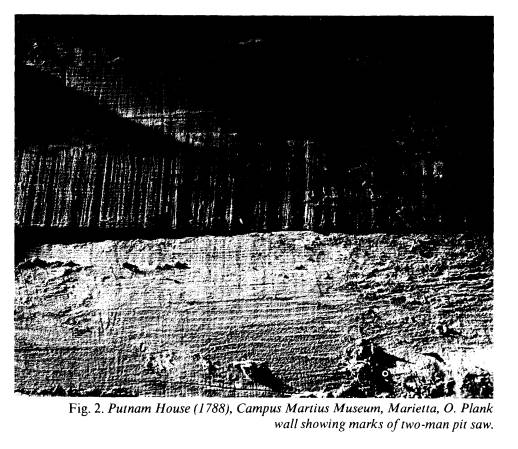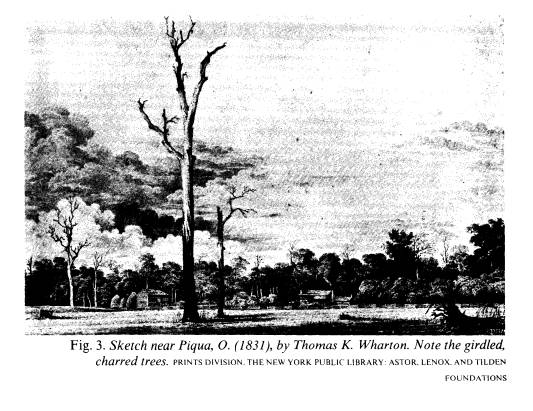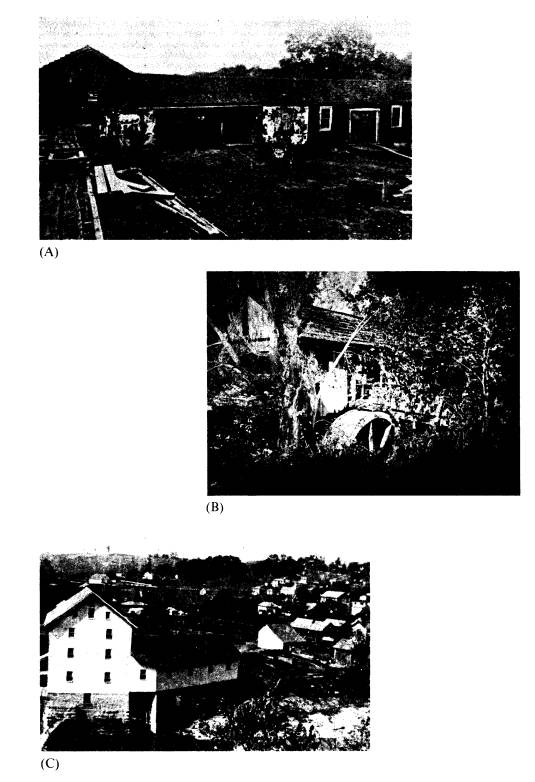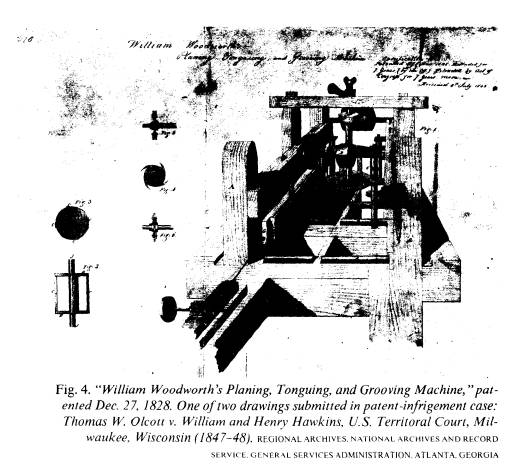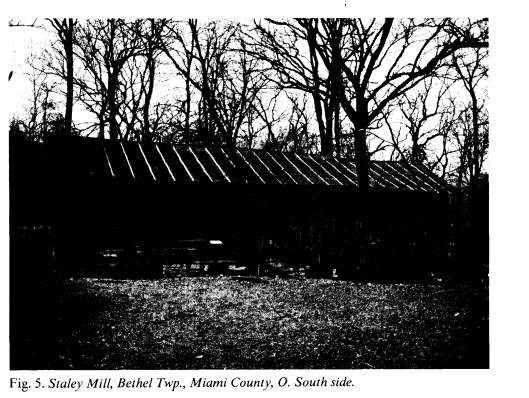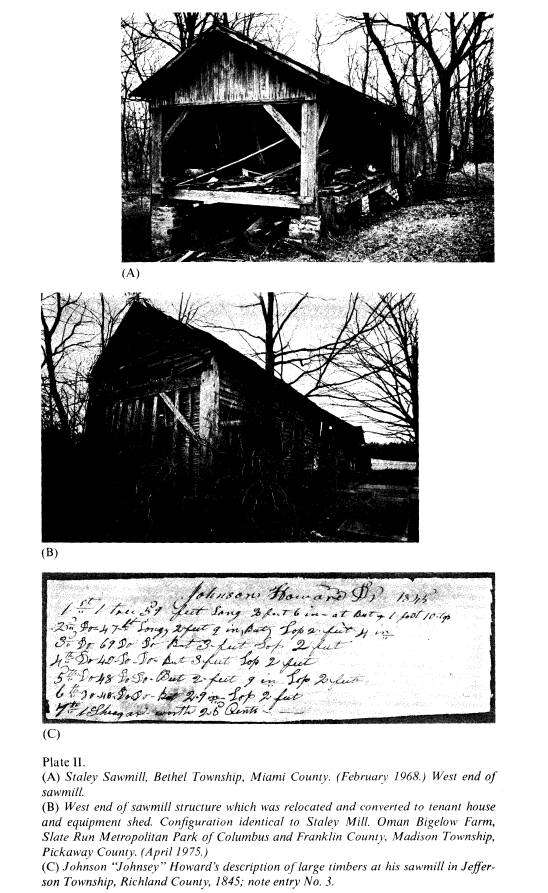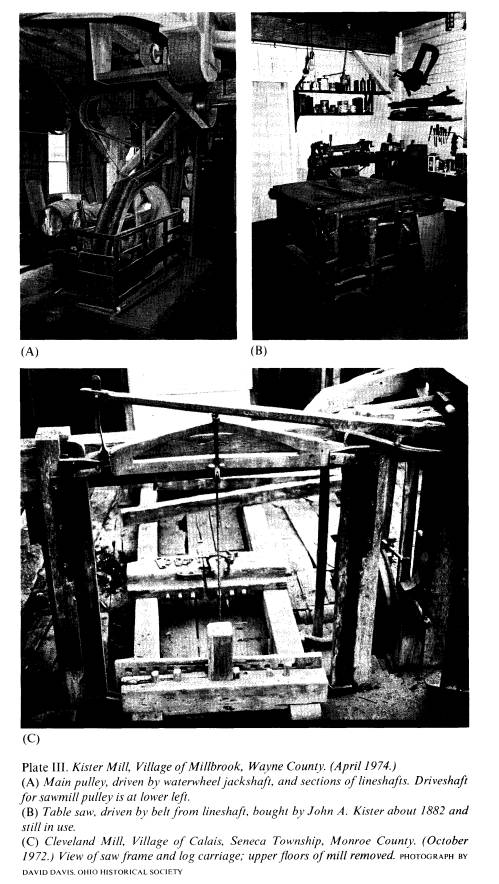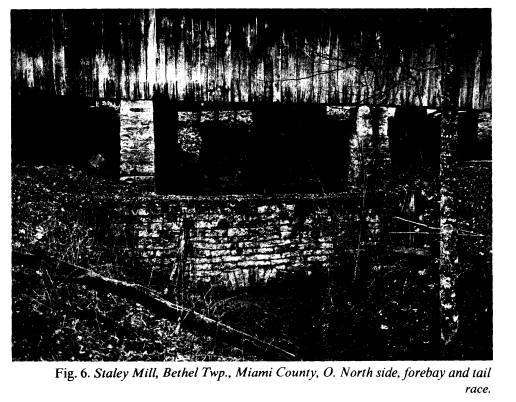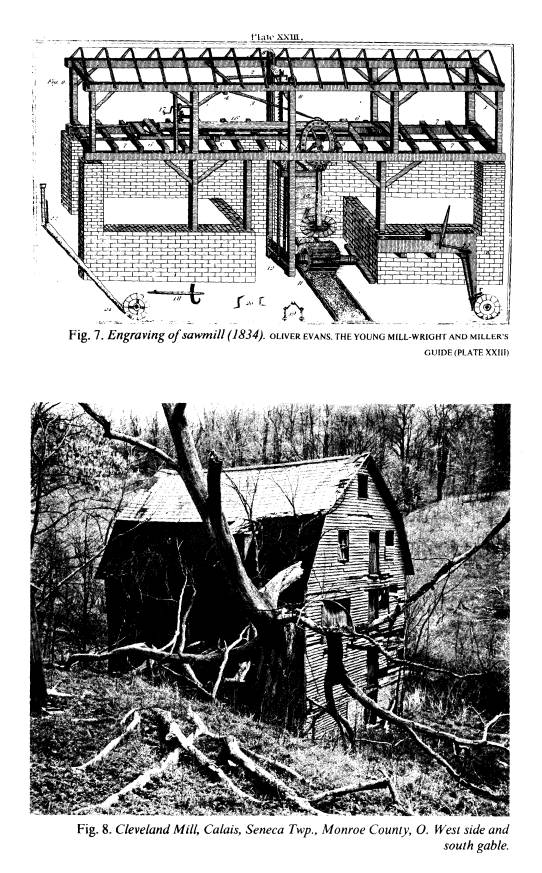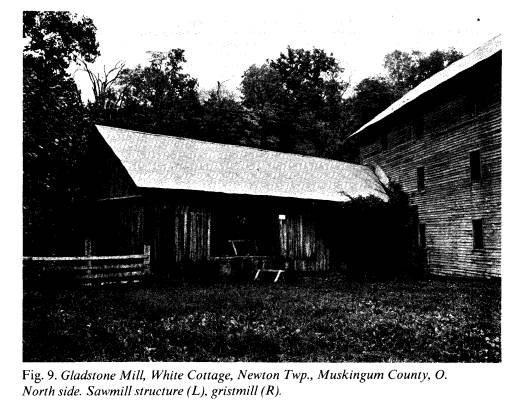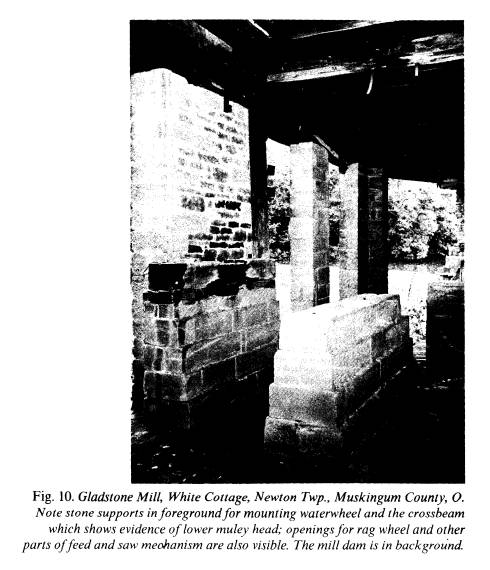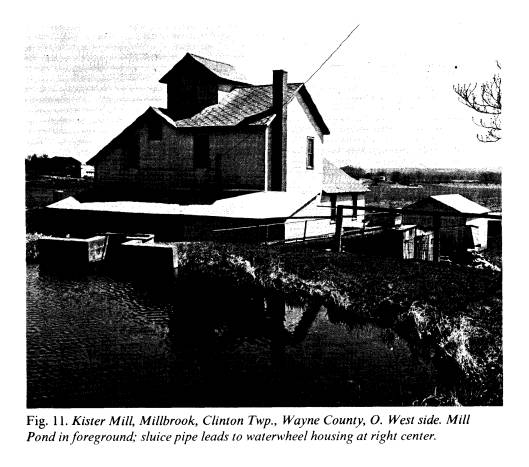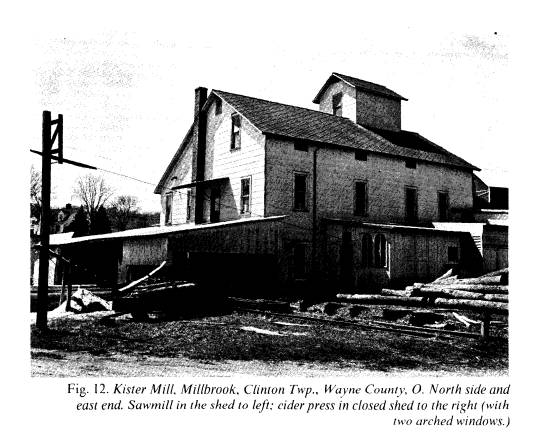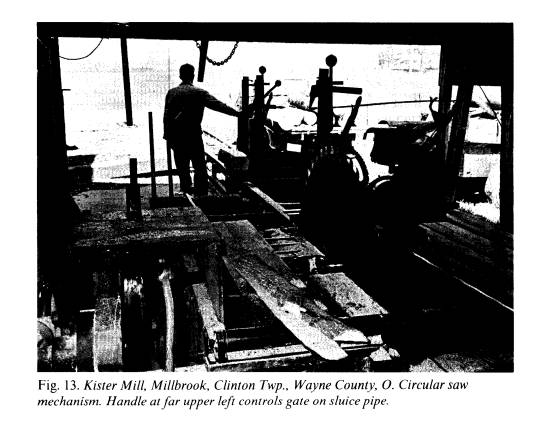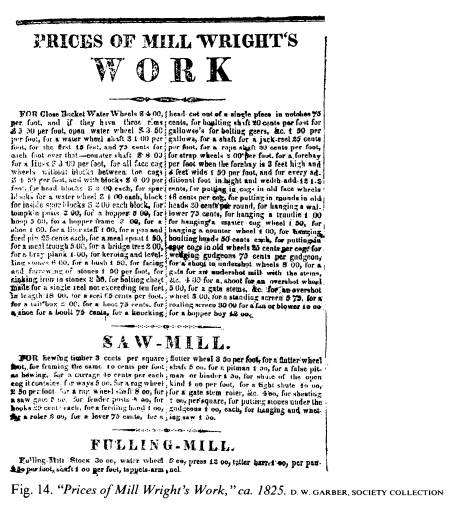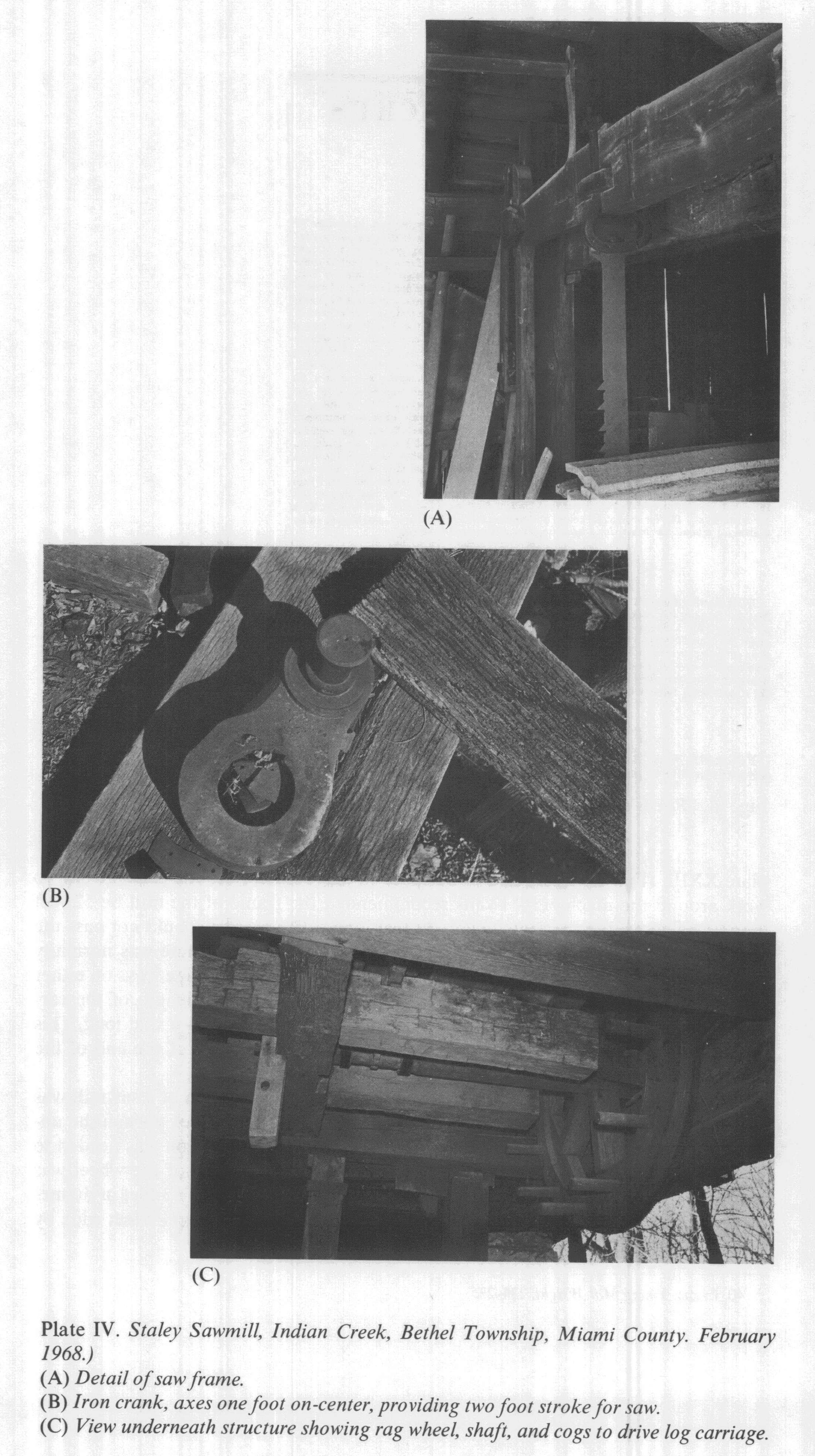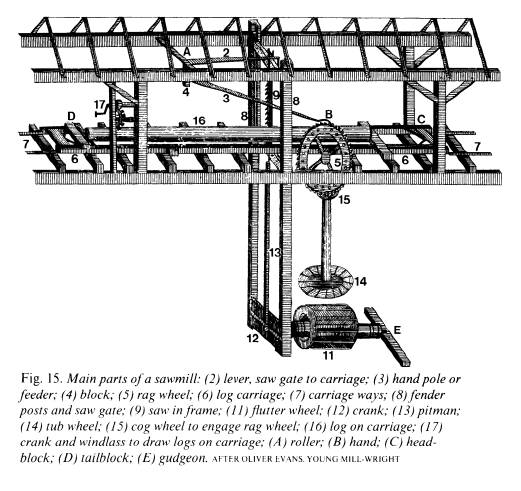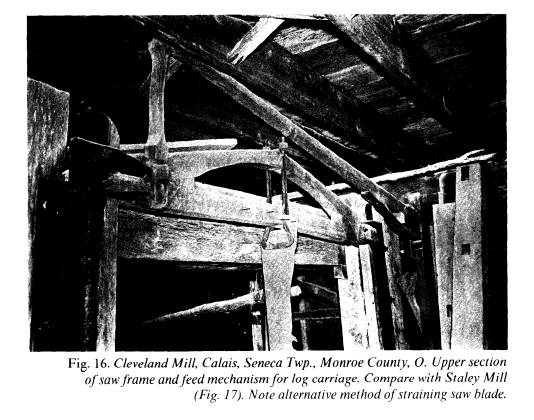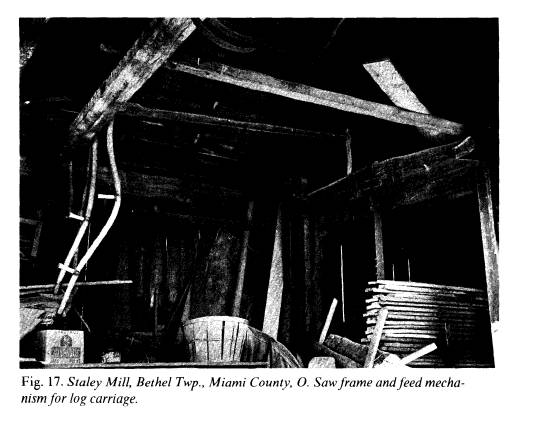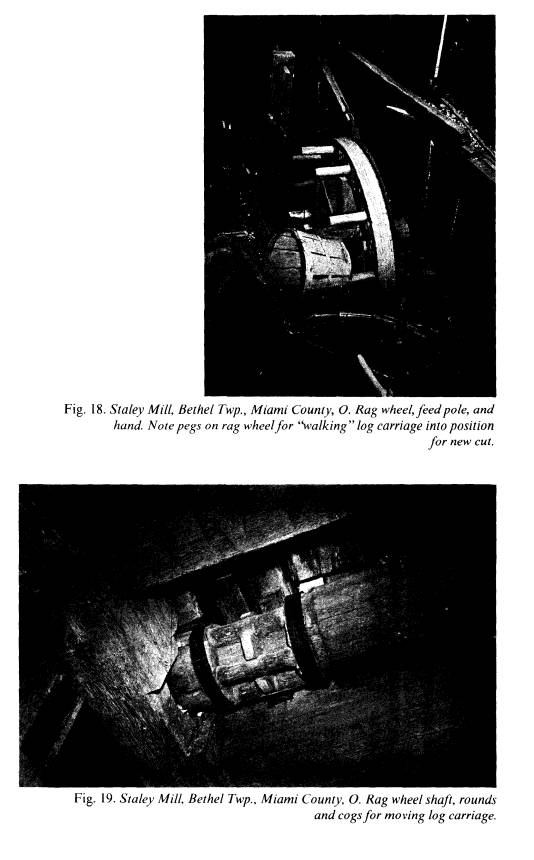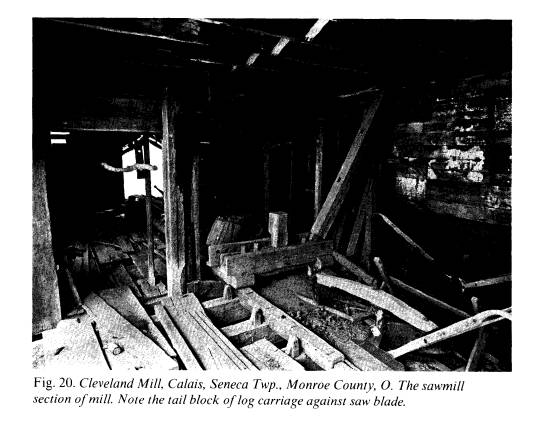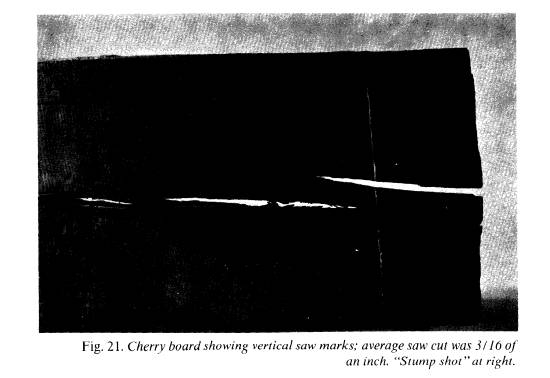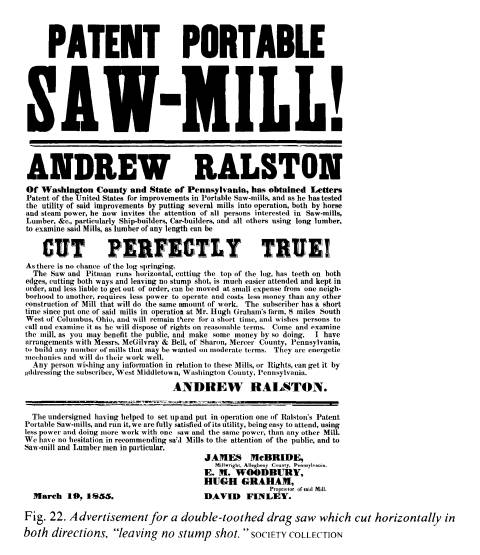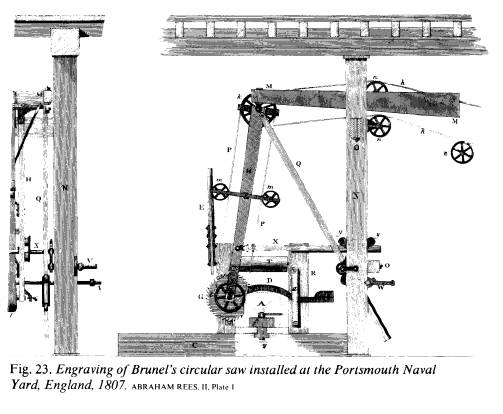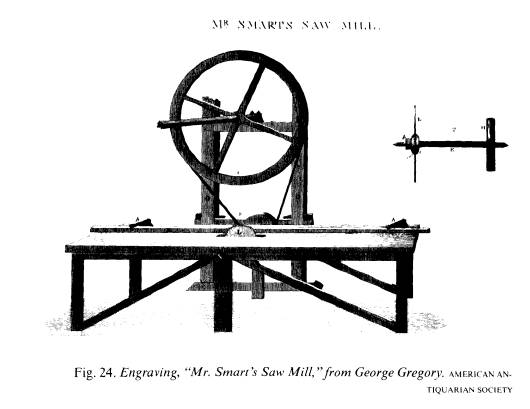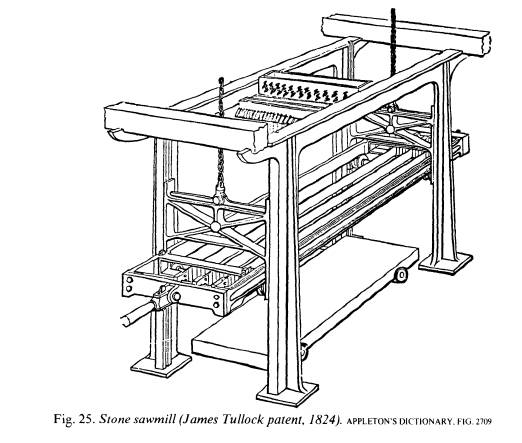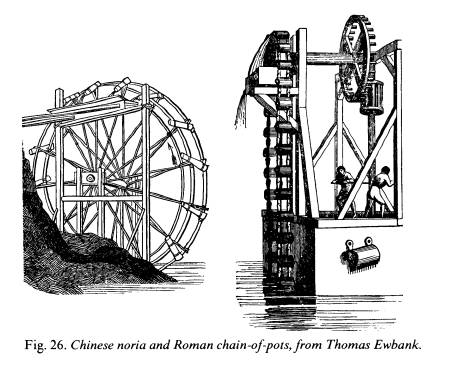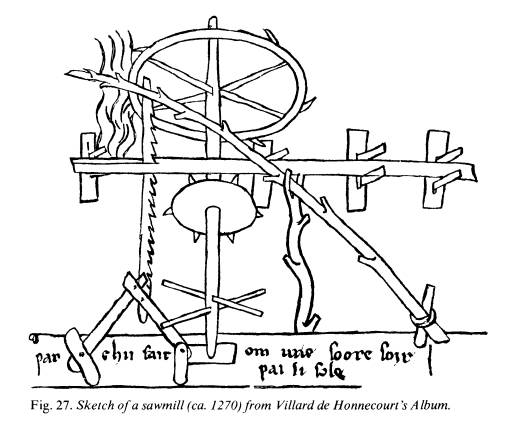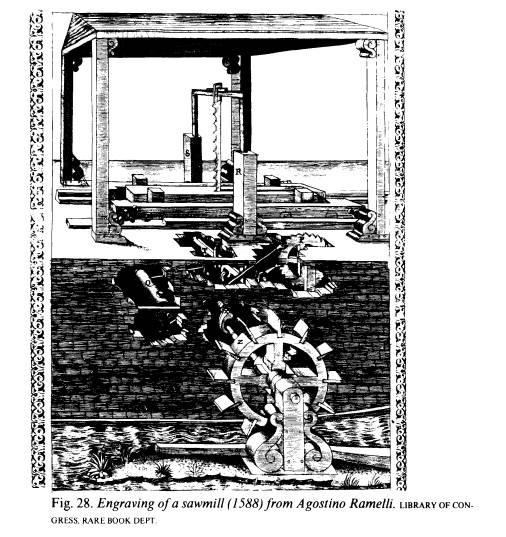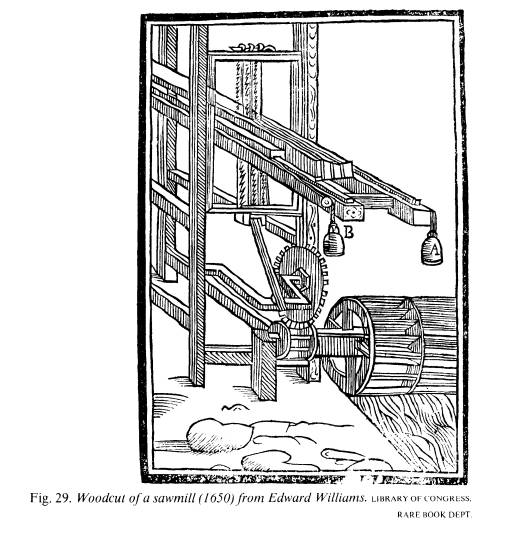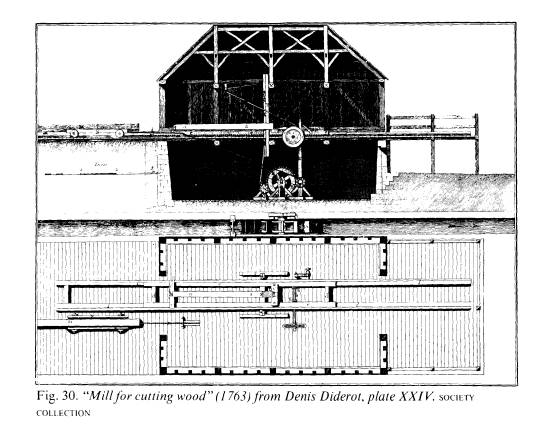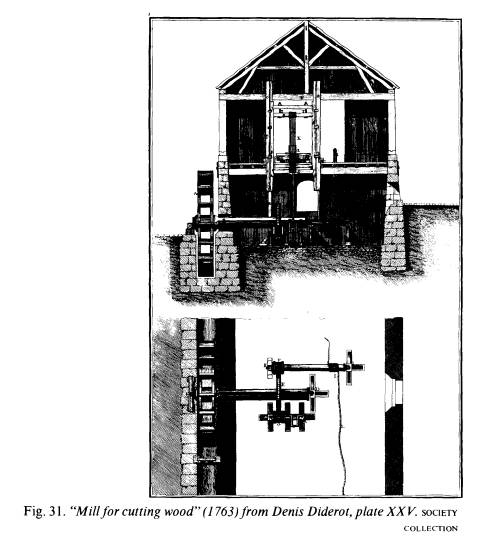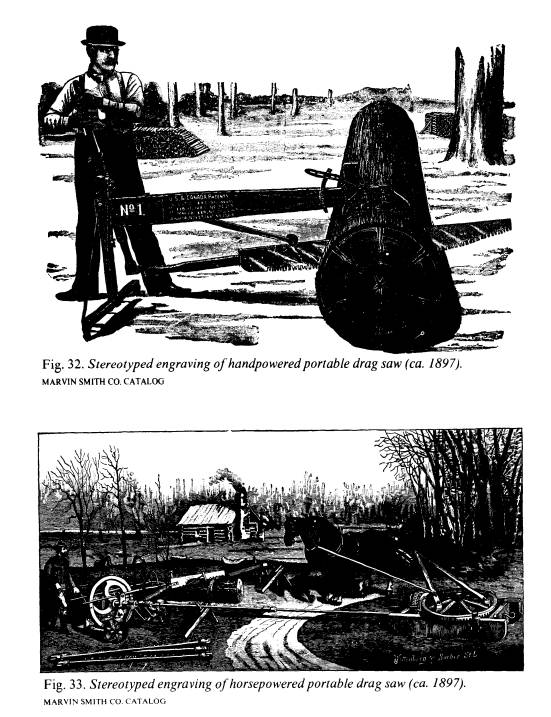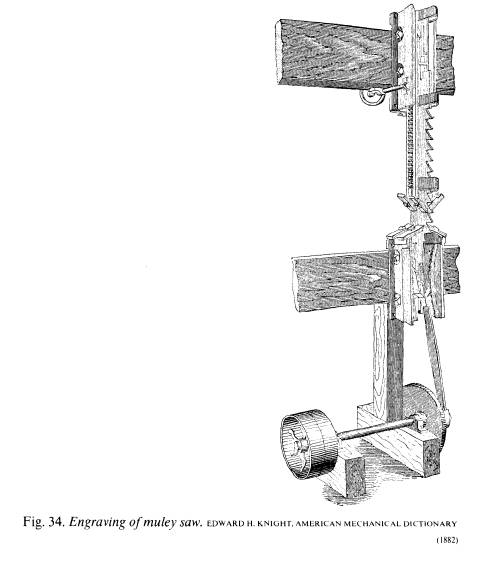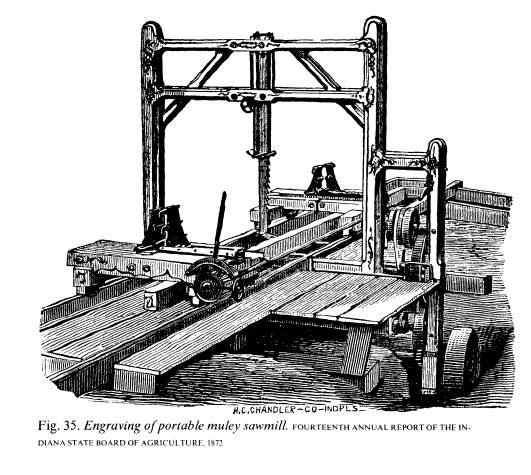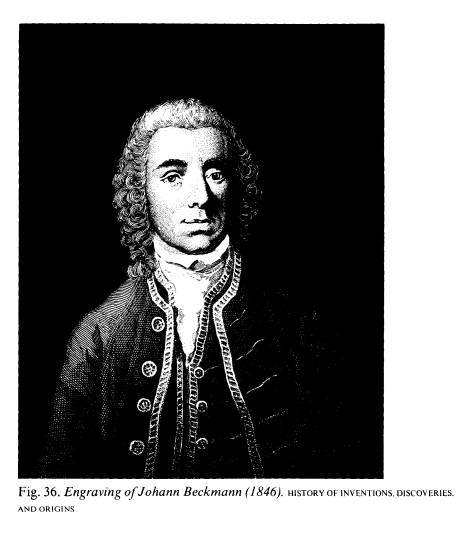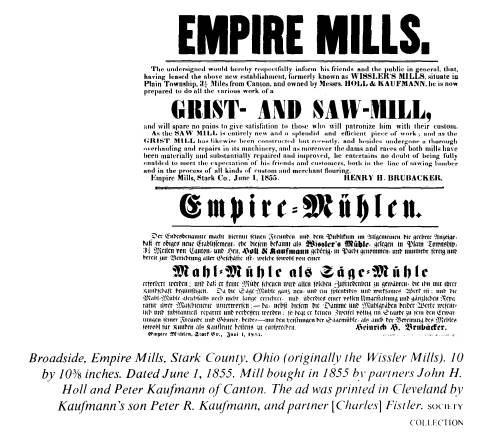Ohio History Journal
DONALD A. HUTSLAR
Ohio Waterpowered Sawmills
Introduction
The reduction of large timber into
useful sizes for woodworking is an ancient
process beginning long before the
written word. Metal tools were not necessary. Be-
fore the advent of metal axes in North
America, the Indians were accustomed to
felling trees by alternately charring
the trunk with fire and breaking away the
burned surface-presumably with large
stone axes. Dugout canoes were also hol-
lowed out in this fashion.
Splitting is undoubtedly the oldest
known means for reducing a tree trunk into
rough planks. This method does not
require metal tools if the wood has cracks large
enough to start a wooden wedge.
Traditionally wooden wedges and mauls have
been used in the United States to split
fence rails. Some split timber is still being
used in the wooden ship building trade
because splitting preserves the strongest
characteristics of wood: the split
follows, whereas the saw often cuts through, the
natural grain structure. Split planks
bend much better than sawed planks. With the
advent of iron tools, the timber was
split roughly to size, then hewed to the desired
dimensions. This was a wasteful process,
but has continued into the 20th century in
many parts of the world. For at least
2000 years moderate size tree trunks have been
hewed into posts and beams for
braced-frame structures; the mortised and tenoned
barns, houses, and outbuildings of the
United States owe their origin at least to the
Romans, if not to an older
civilization.1
By beginning the discussion of saw
milling with splitting and hewing, the implica-
tion is left that cutting wood with a
saw is a latter-day invention. The fact is, the saw
was considered by the Greeks to be so
ancient that its (supposed) inventor was
placed in their mythology. Beckmann
found that classic literature ascribed the in-
vention to the minor gods Talus or
Perdix.2 Talus used the jawbone of a snake to cut
through a small piece of wood, thereby
giving him the idea to form a similar device
of iron. Perdix used the backbone of a
fish for the same purpose. The ingenuity of
1. For further reading on this subject, see
Cecil Alec Hewett, The Development of Carpentry (Newton
Abbott, Devon, 1969); Marcus Vitruvius
Pollio, The Ten Books on Architecture (Morris Hicky Morgan,
trans., 1914 ed. New York, 1960), Book
X, Chap. V, par. 1.
2. John Beckmann, "Saw-mills,"
in A History of Inventions, Discoveries, and Origins (London, 1846), I,
222-224.
Mr. Hutslar is associate curator of
history at The Ohio Historical Society. Unless otherwise designated,
all photographs are by the author.
|
the stories aside, the saw was certainly of some antiquity by the end of the Classic Age in Greece. From this fish-bone beginning, many varieties of saws were devised to meet spe- cific problems of woodworking. A thin blade strained, or tensioned, in a frame could cut more accurately along a line than an unstrained blade. For crosscutting wood, an unstrained blade was required unless the piece was small. Saws could be small enough for a one-hand operation, or quite large and require two men. Today, the handsaw remains a common commodity in hardware stores; the two-man crosscut saw is available to a lesser extent. The "saw pit," developed at an unknown but quite early date, was the first prac- tical answer to the problem of quantity production of building lumber. The saw pit took one of two forms: either a trench was dug in the ground, or the log was ele- vated sufficiently above the ground to allow space for a man to handle the lower end of the large "pit saw." (Presumably the trench was the earliest form, thus giving rise to the term "saw pit.") The lower operator became known as the "pit-man," this term carrying over to the connecting rod used in a waterpowered sawmill. The man handling the uppper end of the saw was called the "top-sawyer"; this term also passed into sawmill jargon to describe a mill foreman. The pit saw was a long, heavy blade which could be made to cut either on the downstroke or on both strokes, the former type being more common. (Fig. 2.) No doubt some form of these blades are still being manufactured, for the saw pit remains common in Far Eastern countries. |
Ohio Sawmills 7
In the United States, the Disston
Company of Philadelphia, at least as late as 1909,
offered pit saws complete with tiller
(upper handle), box (lower handle), and blade.3
Strangely enough, there is a modern
impression that any form of saw was a rare
or unknown item during the settlement of
the North American continent. This
writer has even heard similar statements
made in connection with the settlement of
Ohio early in the 19th century. Though
saws were more difficult to make and were
more expensive than axes, there were few
settlers who did not have some access to a
handsaw. In Ohio, proof of this
statement is no further away than the log houses or
braced-frame barns still in existence
that exhibit hewed timbers with the ends neatly
sawed. Log structures were traditionally
"hewed up" and "sawed down" at the cor-
ners.
The reason few early saws exist today is
probably due to their having been liter-
ally worn away by use and sharpening.
Hewing tools, such as felling and broad axes,
do remain in quantity because they are
intrinsically durable objects and could be
"resteeled" with a new cutting
edge by local blacksmiths. The importance of the
handsaw, as well as the boring auger and
the froe, has been overshadowed by the
more poetic image of an ax in the hands
of a "sturdy pioneer." (It is hard to vi-
sualize a pioneer's wife guarding the
entrance of the little "cabin in the clearing"
against the "dusky denizens of the
forest" with a handsaw! An ax, yes.)
Before outlining the history of sawmills
in Ohio, some aspects of the lumber in-
dustry in the state during the 19th
century should be clarified. A disappearance of
statewide forestation was manifested
after 1815 but was due to many factors, saw-
milling being a major but not
necessarily dominant cause. As much, or more, timber
was destroyed by burning or decay as was
utilized for building purposes.
Before 1800 the entire state was
forested, but to varying degrees; there were a
few, small, open prairies. The Ohio
Biological Survey, Ohio State University, pub-
lished a map (1966) entitled
"Natural Vegetation of Ohio" which defines, topo-
graphically, the various forest areas
found by early survey crews. The best agricul-
tural lands were defined by fairly open
hardwood stands-years of accumulated leaf
mold plus an ever-present shade had kept
the forest floor relatively free of under-
growth. The small river valleys, on the
other hand, were notorious for thick brush
and flood debris; consequently
settlers-as had the Indians before them-picked
trails that crossed such valleys or
paralleled them on ridge lines.
Initial clearing of woodland for
agricultural purposes was accomplished in a
simple way. Rather than cutting the
trees down, the settlers killed them by a process
known as "girdling," that is,
cutting through the sap wood. The tree was allowed to
dry in an upright position, then burned.
(Fig. 3.) If a stand of trees was girdled in
the fall, the land could be cultivated
and planted in the spring. The trees and roots
were simply avoided during cultivation;
and, without leaves, ample sunlight was
available for crops beneath the dead
trees. When winter arrived, burning com-
menced. It was not until large
horse-drawn agricultural equipment was manufac-
tured, beginning in the 1840's in Ohio,
that the stumps presented any problems-
and then due to a desire to farm more
land rather than to the difficulties of working
3. Henry Disston & Sons, Catalog (Philadelphia,
January 1909), 66. The saw pit remained in use in
Canada well into the 20th century. See
Fig. 7, "Whip sawing lumber 1920," p. 15, in the article
"Building
in the North," by Angus Sherwood, APT
Bulletin, VI (1974), 1-25 (Bulletin of the Association for Preser-
vation Technology).
|
around them. Subsequently, the trees were felled with axes, and the stumps usually removed. Even then vast quantities of timber were burned.4 Other factors depleting the forests of Ohio were the general use of wood as fuel for homes and industries; for transportation, by steamboats and locomotives; and for the charcoal iron industry. By the end of the Civil War the iron furnaces of southeastern Ohio were forced either to convert from charcoal to coke or to close. The demand along the Ohio River for steamboat fuel, coupled with the need for charcoal, had literally stripped the adjacent counties of timber. The decline of the forests in the agricultural areas during the period between 1815-1840 can be noted in the problem with squirrels. Their natural habitats and foods were gone, forcing them to feed on cereal grains. Hordes of squirrels in vari- ous areas of the state destroyed crops. Hunting contests were organized to eliminate the animals during which hundreds, even thousands, were killed within a few days. Ohio Sawmills Two sawmills vie for the honor of being the first in Ohio. Both were noted by the prominent early Ohio historian, Samuel Prescott Hildreth, who was in a position to have known the owners or at least to have had first hand information about the in- stallations. Hildreth declared the sawmill on Wolf Creek, "Millsburgh" (present vil- lage of Waterford), Washington County, to be the oldest in Ohio.5 (Fig. 1.)
4. For further comments, see Donald A. Hutslar, "The Log Architecture of Ohio," Ohio History, XXC (1971), 206-207, 239-241. 5. Samuel Prescott Hildreth, "The First Mill in Ohio... ," The American Pioneer (Cincinnati, 1843), II, 99-101. |
Ohio Sawmills 9
In the summer of 1789 Colonel Robert
Oliver, Major Haffield White, and Cap-
tain John Dodge formed an association to
erect a grist and saw mill on land granted
by the Ohio Company. The site chosen was
about a mile from the mouth of Wolf
Creek; due to a bend in the creek the
mill was located only a few hundred yards
from the Muskingum River. A dam was
built across the creek and the sawmill was
constructed first. A 180 pound iron
crank, made in New Haven, Connecticut, was
brought in by pack horse and boat
especially for the new mechanism. The following
year a log gristmill was constructed on
the downstream side of the sawmill, the wa-
ter for the wheel passing under the
sawmill. The gristmill was in operation in March
1790. The Indian wars broke out in
January 1791, but the mills went through five
years of warfare unharmed and were in
existence until about 1840.
Perhaps contradicting himself, Hildreth
describes a second sawmill, supposedly
completed in September 1789, which could
have been the first in Ohio. It was lo-
cated on Duck Creek, the present eastern
limits of the City of Marietta, Washington
County, on land granted to Captain Enoch
Shepherd. Shepherd was joined in this
milling enterprise by Colonel Ebenezer
Sproat and Thomas Stanley. Some lumber
had been sawed at the mill when a sudden
flood removed part of the dam; soon af-
ter, the Indian wars broke out and the
project was abandoned.6 Presumably the in-
habitants of Campus Martius went back to
their saw pits, established in 1788, for
lumber until the wars were terminated by
the Treaty of Greene Ville in 1795.
Unfortunately no further comments on
sawmills during this earliest period of
Ohio settlement have come to light. It
is entirely possible, however, that at least one
more mill existed in the future state.
Fort Washington, in the southwestern corer,
was constructed in 1789, the site now
covered by the downtown area of Cincinnati.
In January 1790, Arthur St. Clair,
Governor of the Northwest Territory, moved the
seat of government from Marietta to
Losantiville, a small village developing around
the fort. According to tradition, St.
Clair is the one who suggested changing the
name of the settlement to
"Cincinnati." 7
During the year of 1790 two frame houses
were erected. In 1792 there were "three
or four" frame houses. By 1795
Cincinnati contained "94 cabins, 10 frame houses,
and about 500 inhabitants." The
following year there were "about fifteen rough, un-
finished frame houses with stone
chimneys." The first newspaper in Ohio, The Cen-
tinel of the North-Western Territory,
was published in Cincinnati from the
fall of
1793 to the summer of 1796. Several
advertisements for frame houses appeared in
the early issues but there was no
mention of a sawmill.8
These frame houses in Cincinnati may
have been of hewed, braced-frame con-
struction with rived, rather than sawed
clapboards. One such house is still in exist-
ence, the "Buckeye Station,"
built by Nathaniel Massie in 1797 on the site of a 1791
log cabin known by that name. (This
house is located in Monroe Township of
Adams County and is on the National
Register of Historic Places.) The mode of
construction would have been little
different, however, even if a sawmill were at
work in Cincinnati: the posts and beams
of the framing would have been sawed
rather than hewed, the clapboards sawed
rather than split with a froe. Assemblage
6. Samuel Prescott Hildreth, Pioneer
History (Cincinnati, 1848), 250.
7. The Cincinnati Directory, for the
Year 1829 (Cincinnati, 1829), 150.
8. Ibid., 150-151; Lewis Alexander Leonard, ed., Greater
Cincinnati and Its People (Cincinnati, 1927),
I, 87, quoting Cincinnati Directory,
1819, p. 29; Centinel of the North-Western Territory, January 4, 11,
February 8, 1794.
10 OHIO
HISTORY
of the components would have been the
same-pegs for the framing, nails for the
siding.
It should also be noted that builders of
log structures did not necessarily adhere
strictly to hewed timber even at this
early date in Ohio. Internal structural com-
ponents, such as joists, rafters,
sheathing, flooring, and boards for doors and parti-
tions, were commonly the products of a
sawmill-if a sawmill was even remotely
available. The ten frame houses in
Cincinnati by 1795, even the ninety-four cabins,
are at least circumstantial evidence in
favor of a sawmill somewhere in the vicinity.
During this same period, 1789-1795, a
larger settlement than Cincinnati was lo-
cated a few miles east at the mouth of
the Little Miami River. This was the village
known as Columbia, which was the center
of a rambling valley settlement roughly
half a mile in width and three miles in
length. Such an area could have supported
more than one sawmill but, again, no
direct evidence has been found.
The next reliable date for a sawmill,
following the abortive attempt at Marietta in
1789, is not until 1798. A sawmill was
constructed for Thomas Worthington on the
North Fork of Paint Creek, four miles
west of Chillicothe, in the spring of that year.
Joseph Yates was the millwright, George
Haines the blacksmith. This mill was
flooded in 1801, but was rebuilt and
used to saw lumber for Worthington's home,
"Adena," at Chillicothe.9
From 1796 on, once the Indian wars were
ended, many private installations such
as Worthington's must have been built.
Even though direct comments are lacking,
the amount of sawed lumber in extant
buildings is mute testimony to the fact. Ac-
cording to the 1800 census of the Ohio
Territory, there were 45,365 residents in the
state.10 This was an ample
population to support several mills. No sawmills were
enumerated in Ohio by Tench Coxe in an
"industrial" census of 1810; in fact, no in-
dustry of any kind was enumerated.11
However, a census taken of Cincinnati in the
same year accounted for 232 frame
houses, 55 log houses, 37 brick houses, and 14
stone houses.12 For
construction of this magnitude there is no question but that saw-
mills were in operation, even
disregarding the number of framed structures that
must have existed in the rest of the
state. Pitsawyers could not have handled the de-
mand unless a significant percentage of
the entire population of Ohio worked in saw
pits.
To show that Ohio was not completely
barren of industry in 1810, Tench Coxe
notwithstanding, an editorial comment
from The Supporter of that year is worth
noting: A company at Marietta was
constructing a steam-powered gristmill, dis-
tillery, and woollen "manufactory
which will not be inferior, if not superior, to any
piece of mechanism of the kind in the
United States." 13 The steam engine was an
Oliver Evans' design of twenty
horsepower. (It is entirely possible one or more
steam engines were also at work in
Cincinnati by 1810.) This is just one good ex-
ample, of many, to show the rapid
internal development that occurred in Ohio early
in the 19th century-in the case of
Marietta, from a "howling wilderness" to a
9. Henry Howe, Historical Collections
of Ohio (Cincinnati, 1847), 434; Diary entry by Thomas Worth-
ington, April 8, 1801, Collections of
the Ross County Historical Society.
10. Compendium of the Enumeration of
the Inhabitants and Statistics of the United States ... from the
Returns of the Sixth Census (Washington, D.C., 1841).
11. Tench Coxe, A Statement of the
Arts and Manufactures of the United States of America, for the Year
1810 (Philadelphia, 1814), n.p.
12. Liberty Hall (Cincinnati),
November 13, 1810.
13. The Supporter (Chillicothe),
October 6, 1810.
|
Plate I. (A) Eason Sawmill, Spring Mill Run, Plain Township, Wayne County. Photograph before 1901. Built about 1870 on the site of an earlier sawmill, this structure housed a waterpowered sawmill, cider press, workshop, and blacksmith shop, and became known as the "Old Curiosity Shop" because of its many activities. (B) Sawmill, Village of Clifton, Greene County. Photograph ca. 1900. Waterwheel ap- pears to be similar in design to wheel in Cleveland Mill. (C) Gladstone Mill, Village of White Cottage, Muskingum County. Photograph taken prior to 1913 flood, which swept away theforebay and waterwheel. Sawmill was in low building on right. |
12 OHIO HISTORY
steam-powered mill in twenty years. This
is also an example of why it is so difficult
to recreate the frontier and settlement
period in Ohio: the primitive building meth-
ods and wilderness conditions of the
frontier existed simultaneously with the in-
troduction of power equipment that was
being developed by the fledgling industrial
revolution.
Once the War of 1812 was settled,
industry boomed in Ohio; proprietors finally
felt their investments safe. By 1819 the
first recorded circular saw made its appear-
ance. According to Martin's History
of Franklin County, this sawmill was con-
structed on the Scioto River in
Columbus, just above Rich Street. The men respon-
sible were Moses Jewett, John E. Baker,
and Caleb Houston. The latter man was a
house and barn builder and was doing
carpentry work on the new state prison. The
sawmill was still operating in 1821;
however, in Martin's words, "It was an experi-
ment, and cost them a good deal, without
ever answering any valuable purpose."14
Probably, Martin knew one or more of the
above men, for Jewett was still active in
Columbus in 1845, about a decade before
Martin wrote his history.
From about 1820 on, fairly concise
information is available on the number of
sawmills in Ohio. The Digest of
Accounts of Manufacturing Establishments under-
taken in 1822 is in the vein of Tench
Coxe's work of 1810. A careful count of saw-
mills listed in all entries in
the Ohio section by the author gave a total of 170.
Defebaugh found only 136 sawmills for
the same 1820 period.15 Apparently he
counted only the entries under
"Lumber" in the Digest or else used an entirely dif-
ferent source. Many industries (such as
furniture companies and distilleries) listed
their own sawmills. Even a total of 170
is probably low, judging by later censuses.
As a sidelight to the wood-building
trade, there were ten mechanized nail factories
in Ohio in 1822, a few owners adding the
comments "little" or "no demand" to their
entries. The fiction that only
hand-forged nails were available is an old one.
It is very unfortunate that an
industrial census was not taken in 1830. The two
decades from 1820 to 1840 are critical
in the general rise of sawmilling in Ohio, not
to mention other industries. During this
interval, probably in the late 1820's, the
planing mill was introduced on a
commercial basis. Once mill-planed "finish" lum-
ber was available to carpenters, the
wood-building industry could flourish at a rate
unknown in the past; the nail factories
were already producing the vast quantities of
nails needed for frame buildings.
The earliest date substantiated for a
combined saw and planing mill in Ohio is an
advertisement from a Cincinnati
directory for 1834:
STEAM SAW MILL, on Elm, between Second
and Third streets, owned by Brooks & Long-
worth, has 1 saw for boards and timber,
one circular saw, and a machine for planing floor
boards, all driven by steam power.16
This mill was listed again in 1836 as
"M. Brooks & Co." It is entirely possible that
this was not the first such mill, for
Ohio city directories are scarce for this period. At
least one more establishment was at work
in Cincinnati by 1839:
HUDSON E. HUGHES, HOUSE CARPENTER &
JOINER, North Side Longworth Street,
14. William T. Martin, History of
Franklin County (Columbus, 1858), 207.
15. Digest of Accounts of
Manufacturing Establishments in the United States . . . (Washington, D.C.,
1823), alphabetized; James Elliott
Defebaugh, History of the Lumber Industry of America (Chicago,
1906-07), I, 489.
16. The Cincinnati Directory
Advertiser, for 1834 (Cincinnati, 1834), 230.
Ohio Sawmills 13
Between Plum and Western Row, WHERE he
has fitted up a large and convenient shop, and
machinery, which enables him to carry on
the above business extensively. Also, Sawing All
Kinds of Venetian Blind Slats, and
Planing Floor Boards By Steam Power.17
By the latter 1830's such a shop must
have been common in any large Ohio city
for, according to the 1840 census, there
were 2883 sawmills at work in the state.18
This is a staggering figure when
compared to the total of 170 mills compiled in 1822.
This fact definitely calls in question
the earlier compilation. Yet, who in Marietta in
1790, faced with an Indian uprising,
would have believed a steampowered mill
would be built just twenty years later?
Perhaps this is just another good example of
the rapid rate at which the Ohio
Country, following the War of 1812, was converted
from frontier conditions to a stable
rural-oriented society. After 1842, when the last
Indian reservations in Ohio were ceded
to the Federal Government, the entire state
ceased to be "frontier" in any
use of the word current at that time. Yet, whatever
impetus the milling industry had between
1822 and 1840, it must have abated some-
what by 1850, for according to the
census of that year there was a total of only 1639
saw and planing mills. The planing mills
probably did not constitute a large per-
centage of the total figure, for ten
years later there were 1862 sawmills and 48 plan-
ing mills.l9 Architectural
historian Charles Peterson went to some trouble to count
the number of sawmills listed in Hawes'
Ohio gazetteer and directory for
1860-1861.20 He found only 437 mills,
174 of which were powered by steam. (The
discrepancy between the sawmill count of
1862 and 437 is probably due to the fact
that it cost money to be listed in the
gazetteer.)
The first Hawes' gazetteer was published
in 1859. It contained an extensive list of
sawmills as well as nine saw and saw
blade manufacturers. The advertisement of the
Cleveland Saw Manufactory was typical
for the period:
Every description of Saws, Circular,
Mill, Pitt [sic] and Cross-cut, on hand or made to order.
All kinds of Saws Re-Toothed,
Straightened, Set and Sharpened. Handles put to Cross-cut
and Hand Saws, and new Saws fitted for
use ... Particular attention paid to the manufacture
of CIRCULAR AND WEB SAWS, for Cutting
Iron, Brass, Shell, Bone, Ivory, &c ...
The Woodrough and M'Parlin Company of
Cincinnati advertised they were manu-
facturers of "Patent Ground
Circular Saws" as well as "Mill, Mulay, Cross-cut,
Veneer, and Web saws." 21
The acceleration of industrialism during
the Civil War, caused by the interaction
between the increased need for goods and
the development of the technology neces-
sary for their production, is reflected
in the 1870 census: 2230 mill establishments,
running 3177 saws, powered by 1628 steam
engines and 580 waterwheels and tur-
bines.22 This increased
productivity continued through the ensuing decade, 2352 es-
17. Shaffer's Advertising Directory
for 1839-40 (Cincinnati, n.d.), 36.
18. Sixth Census (1841), 284.
19. Defebaugh, Lumber Industry, 490;
Manufactures of the United States in 1860; Compiled from ... the
Eighth Census (Washington, D.C., 1865), 486.
20. Charles E. Peterson, "Sawdust
Trail, Annals of Sawmilling and the Lumber Trade ... to the Year
1860," APT Bulletin, V
(1973), 88; George W. Hawes, Ohio State Gazetteer and Business Directory for
1860-61 (Indianapolis, 1860), 893-897.
21. George W. Hawes, Ohio State
Gazetteer and Business Directory, for 1859 and 1860, No. 1. (Cincin-
nati, 1859), 147, 186, 703-706.
22. Francis A. Walker, comp., The
Statistics of the Wealth and Industry of the United States... from the
Original Returns of the Ninth Census (Washington, D.C., 1872), III, 612. The total figures
given for saw
and planing mills in this compilation do
not agree, or at least are not explained fully enough to under-
stand; pp. 453-454 give totals at
variance with p. 612.
|
tablishments being reported in 1880. To round out the century, for 1890 Defebaugh showed the figure of 1461 establishments, which is a surprising and unexplained drop and may refer to sawmills alone. And, for 1900, he gave a total of 2023 sawmills and 354 planing mills.23 The hypothetical date of 1830 probably marked several turning points for the lumber industry in Ohio. For one thing, the planing machine had become com- mercially feasible for smaller sawmills; William Woodworth's planer, patented in 1828, was an industry standard until the 1840's.24 (Fig. 4.) A sawmill with a planing machine could provide flooring, molding, dimensioned lumber for finish work: that is, ready-to-use products which normally had to be hand-planed by the carpenter. Another factor leading to the expansion of the lumber industry was the gradual rise in the use of the circular saw. Its importance lay not in the production of rough lum- ber from the log, for which the vertical gang saw was admirably suited, but in the increased output of dimensioned finish lumber, particularly long narrow boards used for flooring, lath, molding, and sash. The circular saw was also adaptable to cutting mortises and tenons, dovetails, rabbits, tongues and grooves, and other joints
23. Defebaugh, Lumber Industry, 493, 494, 509, 512. 24. An interesting series of articles concerning the planing machines of Woodworth and Bicknell and their patent-infringement lawsuit may be found in Charles Cist, The Cincinnati Miscellany, or Antiquities of the West (Cincinnati, 1846), I1, 44, 48, 130-131. |
|
Ohio Sawmills 15
and shapes that the carpenter and joiner had been accustomed to forming with handsaws, chisels, and planes. A third development important to the sawmilling industry was the increased ap- plication of the steam engine. A portable power source freed a mill from a fixed site near a pond or river, allowing the mill to be moved to the timber. The steam engine also permitted large saw and planing mills to be constructed in urban areas; this was of particular advantage by 1840 when many of Ohio's larger cities were being inter- connected by a youthful rail and canal system. In fact, the figure of 2883 sawmills for 1840 probably does reflect a mutual interchange of the need for wood products fostered by the rush for transportation improvements in the state, and by specula- tion on the advantages for out-of-state trade to be gained by such improvements. It is now known that the internal growth of the state was bolstered greatly by the canals and railroads, but that the expected rise in exportations did not occur; this may account, in part, for the reduction in sawmill establishments by 1850.25 Extant Waterpowered Sawmills The list of remaining waterpowered sawmills is quite short: the Staley, Cleveland, Gladstone, and Kister mills. Even this list is misleading, for the Cleveland Mill has been disassembled, and the works are missing from the Gladstone Mill. Some traces |
|
25. Harry N. Scheiber, Ohio Canal Era: A Case Study of Government and the Economy, 1820-1861 (Athens, 0., 1969), 183-268. |
|
18 OHIO HISTORY
of other sawmill structures do remain in varying stages of decay. It is possible that there are one or more complete sawmills still hidden about the state; however, D. W. Garber, the authority on gristmilling in Ohio, has traveled the state exten- sively and could not add to the above list.26 The Staley Mill, Bethel Township, Miami County (Figs. 5, 6), is a classic example of a vertical sawmill following the design in Oliver Evans' book, plate XXIII.27 (Fig. 7.) It is the last of three sawmills constructed by Elias Staley, who bought the farm in 1816 on which it stands. He died in 1866. The present mill was probably built late in his lifetime, though no definite date has been found for its construction. Typolog- ically, the mill could be one or two hundred years old and is an excellent example of the style of sawmill that would have been in use in Ohio before the War of 1812. The Staley family operated a gristmill, sawmill, and distillery on their farm for al- most ninety years, apparently ceasing operations in 1905.28 The last log sawed is still on the carriage. The mill superstructure and saw mechanism are in fairly good condition, though the forebay, waterwheel, and some attendant mechanisms have rotted away. The |
|
26. D. W. Garber, Waterwheels and Millstones: A History of Ohio Gristmills and Milling (Columbus, 1970); private correspondence with Mr. Garber, 1973-1974. 27. Oliver Evans, The Young Mill- Wright and Miller's Guide (Philadelphia, 1834), plate XXIII. 28. Thomas C. Harbaugh, Centennial History of Troy, Piqua and Miami County, Ohio (Chicago, 1909), 326. |
Ohio Sawmills 19
sawmill received its water supply from a
sluice off the main mill race supplying the
gristmill. The latter was powered by two
overshot waterwheels, consequently the
race was quite a large channel which,
oddly enough, ran directly through the farm
between the house and barn and thus
required a bridge. However, the mills and the
distillery were the main functions of
the "farm," for it is recorded that Elias "never
engaged in farming the place." 29
The Cleveland Mill (Fig. 8) was located
near the small village of Calais in Seneca
Township, Monroe County.30 (It
was purchased and disassembled by The Ohio His-
torical Society in 1972, hopefully to be
reassembled as part of an "Historic Village"
complex.) The combined grist and saw
mill began its service in 1850 when the saw-
mill section was constructed by one
Robert Harper of Barnesville in Belmont
County. The two story mill,
approximately 45 by 16 feet in dimension, was built in a
small valley adjacent to a hillside. A
mill race was run down the valley on the side of
the hill. A bridge, or platform,
extended from the hillside to the second floor of the
mill where the sawing mechanism was
located. Lumber and waste material could be
removed from openings at either end of
the structure.
The mill was powered by a 15 foot 8 inch
overshot waterwheel which, instead of
buckets or vanes, had a corrugated
surface formed in the manner of clapboard sid-
ing. All power transmission in the
sawmill was through belts and pulleys. It is im-
possible to say if this was the original
mechanism of 1850-it certainly could have
been-or one of two later alterations to
the structure and mill equipment. In March
of 1863 Harper sold the sawmill to
Thaddeus Cleveland, a local farmer and mer-
chant. In 1865 Cleveland added a pair of
millstones to the original structure; then,
in 1870, the entire mill was doubled in
size by extending the width to 32 feet and
adding three upper floors. Two pair of
millstones were installed in the new section
along with the necessary grain-handling
equipment. The gristmill was powered by a
jackshaft operated by a section gear on
the flange of the waterwheel.31
The mill was taken over by William N.
Cleveland shortly before his father died in
1901. The business had declined for some
time and apparently the mill was allowed
to fall into disrepair. In the July 1,
1909 issue of The American Miller, Cleveland an-
nounced his temporary retirement from
milling, but the following year he planned
to "install a new waterwheel, put
in a new forebay and rebuild the dam and waste
gates at the plant before commencing
milling again." 32 The mill, however, was
never restored to service, but before it
was dismantled it had been preserved in rea-
sonably good condition since the lower
floor was used as a barn and two of the up-
per floors as workshops.
The saw and carriage are quite similar
to the Staley Mill, the chief difference
being that the ratchet mechanism moving
the carriage had to be placed at a right
angle to the carriage because of the low
ceiling height. It is possible that in the origi-
nal 1850 structure the configuration was
the same as the Staley Mill and as shown
by Oliver Evans, plate XXIII. (Fig. 7.)
It is also possible that the original power
transmission was by belts and pulleys
and not directly by the waterwheel axle as
shown by Evans, and apparently used in
the Staley Mill. The use of belts and pul-
29. Ibid.
30. Garber, Waterwheels and
Millstones, 99-101.
31. Ibid., 99.
32. Ibid, 101.
|
leys was recommended by William Hughes, a lesser known authority on milling, in his book of 1851.33 The flexibility of the system, as opposed to direct drive or toothed gears, reduced the amount of vibration inherent in the reciprocating motion and al- lowed the saw mechanism to absorb shocks with less possibility of breakage. Some furniture must have been produced at the Cleveland Mill, for there was a large belt-driven turning lathe made of wood on the fourth floor and what appeared to this writer to be an unfinished corner post for a bed lying in the debris. Garber was told that coffins were among the last items made at the mill.34 Indeed, there was a diamond-shaped coffin lying on the log carriage. The Gladstone Mill (Figs. 9, 10) is located in the village of White Cottage (for- merly Newtonville), Newton Township, Muskingum County. The original gristmill structure dates to 1813. The mill had various owners until 1864, when William and David Gladstone acquired the property. There is an illustration of the mill in an 1875 atlas of Muskingum County. The caption under the illustration states that the mill was "Rebuilt 1875." According to Garber, the Gladstones enlarged the mill af- ter the Civil War and added the sawmill at that time-the date being 1875, if the atlas is correct. The illustration does show a structure where the sawmill is presently located, though it is suggested rather than detailed.35 The mill was operated until the "Great Flood" of March 1913 swept away the
33. William Carter Hughes, The American Miller, and Millwright's Assistant (Philadelphia, 1851), 184-185. 34. Garber, Waterwheels and Millstones, 99. 35. Ibid., 127; L. H. Everts, Combination Atlas Map of Muskingum County, Ohio (Philadelphia, 1875), 76. |
|
forebay and waterwheels. Because of repair costs and competition the mill was not repaired. A small amount of equipment remains in the gristmill, but the sawmill equipment was removed long ago; however, the structure that housed the saw is in good condition and very interesting for the few details that remain. The crossbeams that held the saw mechanism clearly show that "muley-heads" had been installed, not a sash frame. The ways for the log carriage are still in the floor because they were mortised into the joists and could not be easily removed. The stone foundation for the sawmill section is well constructed, surviving the 1913 flood with little dam- age. The stone supports and one pillow block for the waterwheel remain. The wheel could have been eight to ten feet in diameter, perhaps larger. It is now hard to deter- mine what type of wheel was used; but from the pitch of the rocky shelf below the wheel, with drainage back towards the mill dam, it may have been a breast wheel. The apparent closeness of the wheel to the floor joists lends some support to this hy- |
|
pothesis, as does the fact that the water had to be conveyed from the dam to the wheel through a long wooden sluice trough. All of this speculation does not rule out the possibility of an overshot wheel, however. Various closed apertures through the present floor account for the mechanisms necessary to regulate the water flow and the movement of the log carriage. Even without its saw and waterwheel, the Gladstone Mill remains an excellent example of late 19th century mill construction, clean and functional in its design solidly built. If the saw equipment were available, the mill could easily be put into operation again. The Kister Mill (Figs. 11, 12, 13) differs significantly from the previous sawmills- not in the fact that it contains a circular instead of a reciprocating saw-but in the fact that it is still operating, and with an overshot waterwheel. The Kister family had many opportunities to alter the power source during the eighty years of the present mill's existence, but preferred to keep the waterwheel. The Kister Mill, which is listed in the National Register of Historic Places, is lo- cated in the village of Millbrook, Clinton Township, Wayne County. A gristmill was first built on the site in 1816. Jacob A. Kister acquired the mill and converted it into a woolen mill in 1845.36 The mill was sold in 1875, then repurchased in 1881 by John A. Kister, who returned the structure to a gristmill. Kister tore the old mill down in
36. Garber, Waterwheels and Millstones, 124. |
|
1894 and built the present structure from both old and new material. The new mill combined the functions of a grist and saw mill, woodworking and machine shop, and cider press. Much of the shop equipment had been purchased in the early 1880's, including a table saw and wood planer, and these items remain in use today. The Kisters made and installed various types of mill equipment throughout Ohio and adjacent states. They built several waterwheels to order at their mill, disassembled and then reassembled them on-site. In 1934 Guy S. Kister became the third generation owner of the mill. He made one more alteration to the structure-the removal of the waterwheel from inside the mill to a separate building a short distance away to eliminate water damage to the main building. In 1967, a year before he retired and sold the mill, Mr. Kister, then eighty-three years old, designed and helped build a new overshot waterwheel, the third such wheel since 1894. This writer had the pleasure of touring the mill with Mr. Kister in the spring of 1974. The entire mill structure and its contents were in immaculate condition. Basically, the mill is a three-storied building: the ground floor houses the heaviest equipment of the woodworking shop and the main line shafting, with the sawmill under a shed roof to the east and the cider press in a room to the north; the second floor is divided between woodworking and gristmilling equipment; and the third floor contains the storage bins and elevators for the gristmill operation. The water- wheel is housed a short distance south of the main building. The mill race begins as a spring-fed stream on the northwest side of Millbrook, runs through the north edge of the village, and ends in a mill pond slightly above the mill; an iron sluice pipe |
|
runs from the pond to the wheel, where the water is controlled by a sluice gate oper- ated by a roller shaft from many different stations within the mill. The mill race once served several mills along its course. The circular saw equipment in the mill is typical for the late 19th, early 20th cen- turies. (Fig. 13.) The saw blade, which has inserted teeth, is 56 inches in diameter. The power train begins with an 18 foot, 6 inch waterwheel, which turns about 8 rev- olutions per minute. An internal-spur master wheel is connected to the waterwheel axle; one revolution of this gear turns the jackshaft gear eight revolutions. The jack- shaft runs from the waterwheel housing to the ground floor of the mill, ending in a main lineshaft pulley. Power for the saw is transmitted from the jackshaft to a drive pulley by means of bevel gears; the drive pulley is belted directly to the saw and carriage mechanism. Mr. Kister says the saw blade runs at about 450 revolutions per minute. This would be about 6600 peripheral feet per minute for a 56 inch blade, which is slightly less than the speed, 6800 FPM, recommended by Bale for ripping hardwood.37 There is no question that the saw works, and has worked for eighty years. The wa- terwheel is four feet wide, and the pond can deliver 250 cubic feet of water per min- ute, so the wheel is capable of operating the entire mill, not just the saw. Mr. Kister rates the waterwheel at eleven horsepower. The Kister Mill is one of the best late 19th century industrial sites in Ohio, and it
37. M. Powis Bale, Woodworking Machinery... (London, 1880), 215. |
26
OHIO HISTORY
is hoped that it will be maintained as
well in the future as the Kister family has
maintained it in the past. It is indeed
fortunate that such a variety of 19th century
waterpowered sawmills are extant in
Ohio. The Staley Mill represents the standard
vertical mill as delineated by Evans;
the Cleveland Mill illustrates the alternate
belted power train recommended by
Hughes; the Gladstone Mill presents the hous-
ing for a muley saw; and the Kister Mill
is a working example of a circular sawmill.
One could wish, of course, to add to
this list-and a worthy addition would be the
Hoge Lumber Company of New Knoxville,
Auglaize County. The company was
founded by Herman H. Hoge in 1904 and
remains in the family. Initially the mill
was powered by steam engines and
lineshafting. The steam boilers were heated by
burning all mill debris, such as
"off-falls" and sawdust; the practice continues today.
In 1935 electrical generators were installed,
powered by two steam engines. About
ten years ago a steam turbine was
substituted for one engine; then, two years ago, a
second turbine replaced the remaining
engine.
For all practical purposes, such a plant
could have been operating in the last
quarter of the 19th century. Bale,
writing in 1883, speaks of having "seen a large cir-
cular saw bench driven by
electricity." He further states, "We trust we may not be
accused for being before the times when
we prognosticate a future for electricity in
connection with woodsawing and
conversion." He was speaking of England, but the
United States paralleled England in the
application of electrical energy to
woodworking mill machinery.38
The Construction and Operation of a
Vertical Sawmill
Basically, the mechanical operation of
every vertical waterpowered sawmill was
the same; there was little variance in
equipment design, and the function of the mill
and its equipment predetermined the
design of the mill foundation and super-
structure. Any stonemason could have
handled the foundation work for a mill, any
barn or house builder the braced-frame
superstructure. The construction and align-
ment of the saw mechanism, on the other
hand, probably did require the services of
an experienced millwright. In the
advertisement "Prices of Mill Wright's Work"
(Fig. 14), hewing and framing timber is
mentioned under the sawmill heading but
not in the longer section dealing with a
gristmill. The superstructure of a sawmill
was not a complex building problem; and
as part of the mechanism was tied directly
to the framing, the carriage ways and
the fender posts in particular, perhaps the en-
tire building was considered the
province of the millwright. No doubt the millwright
had strict control of the foundation
work, even if he did not build it, because of the
nature of the equipment to be installed
in that area.39
There was no reason a sawmill had to
conform to a plan such as shown by Evans,
but apparently most did. There were not
many configurations a sawmill could as-
sume; a building could be taller or
longer, certainly wider than shown in Evans'
38. Ibid., 46.
39. Chapter 23 on sawmilling by Thomas
Ellicott in Oliver Evans' book (fn 27 above) is well worth
reading. It was used as a standard
reference for this article. There are also descriptions of construction
and operation of a vertical sawmill in
Henry C. Mercer, Ancient Carpenters' Tools (Doylestown, Pa.,
1960) and in Bale's Saw-Mills (fn
57 below). A recent commentary on the rebuilding and operation of a
vertical mill may be found in John M.
Dickey, "Restoration of the Bertolet Sawmill," APT Bulletin, V
(1973), 155-161. Vertical mills are
presently being demonstrated at Old Sturbridge Village, Mass., and
Upper Canada Village, Morrisburg,
Ontario.
|
plate XXIII. (Fig. 7.) There had to be space to move the logs to the carriage and to work around the machinery. Evans recommended the frame of the mill be 52 feet long, the sides of the carriage 29 and 32 feet long.40 The carriage could not pass the saw blade because of the head and tail blocks. Since the saw frame was normally placed in the center of the structure, with less than 26 feet of carriage ways on either side, plus the added width of the blocks shortening the overall length of the car- riage, it is doubtful if a log over 25 feet could have been handled-if that long. This is assuming that in normal operation the saw was stopped short of the end of the log; a solid butt was needed to fasten the log on the carriage. Unlike many other types of waterpowered mills, the power train of a sawmill was quite simple. The hydraulic motor could be any form of waterwheel, though the un- dershot "flutter" wheel was commonly used because a rapid rotation was needed to give the saw blade approximately 2 strokes per second. The size of the wheel was governed by the head of water; for example, a wheel 5 feet wide by 3 feet in diame- ter required a 12 foot head. A very low, 5 foot head required a wheel 9 feet wide by
40. Evans, Young Mill- Wright, 234-235. |
|
21/2 feet in diameter. The number of buckets, or vanes, on flutter wheels varied, but 9 seems to have been an average.41 The wheel axle revolved in "gudgeons" at either end; the gudgeons, in turn, rested on "pillow blocks," which were adjustable to al- low the wheel to be leveled. (Fig. 15.) At one end of the axle was the crank, usually made of iron, which could be of any length depending on the amount of stroke desired. Attached to the end of the crank and to the bottom of the saw frame was the "pitman," a strong wooden rod, custom- arily made with a double taper, roughly 4 by 4 inches. The name, "pitman," comes directly from pit-saw terminology, the pit-man being the sawyer handling the lower end of the saw. Most sawmills had a "penstock" or "forebay," a wooden box reach- ing from the top of the mill race to the bottom of the tail race. Water flow from the penstock to the wheel was controlled by a gate, which was operated by a lever usu- ally placed near the saw frame. Raising or lowering the gate was the only method for starting or stopping the saw. There were several critical adjustments in the operation of a mill: the alignment of the saw frame and fender posts; the hanging of the saw blade; the amount of feed
41. Ibid, 345. |
|
given the wood to be cut; and, the speed of the cutting strokes. The saw blade was held in a rigid rectangular frame that oscillated vertically be- tween two fender posts, the frame sliding in mortises in the posts. (Fig. 16.) The fender posts were wedged at top and bottom into open-face mortises in two cross- beams; the alignment of the fenders could be adjusted by moving the wedges. Alignment was a constant problem because of the vibration of the saw frame, pit- man, and crank. If the saw frame was too tight, it would bind; if too loose, the blade would wander. The length of stroke varied according to the size of the crank, and was determined by the type of wood normally cut and the design of the saw teeth; an average stroke was between 18 and 24 inches. The saw blade had to be hung and strained as precisely as possible. The type of wood being cut determined the amount of "lead," or the distance which the top of the blade overhung the bottom, necessary to allow the blade to cut on the down- ward stroke and sawdust to escape on the upward stroke. Bale recommended leads of one-fourth inch for hardwood and one-half inch for softwood. The blade was usu- ally strained, or tightened, by means of keys or wedges on the top rail of the frame. Bale believed the only way to know if a blade was strained correctly was by its "pe- culiar cry or sound" as it was being tightened. A loose blade was likely to buckle.42 The speed at which the log was moved by the carriage to the saw was to some de- gree dependent upon the number of strokes made by the saw per minute. Even though the strokes per minute were variable, 120 was an accepted standard for a
42. Bale, Woodworking Machinery, 205. |
|
single blade, sash frame saw. On this basis Bale estimated that hardwood could be fed one foot, and softwood three feet, per minute.43 The mechanism that governed the feed looks complicated in illustrations, and is somewhat difficult to explain in writing, but nonetheless was simple in operation. A wooden (hickory) spring was at- tached to the top of the saw frame. This spring allowed a flexible connection, by means of a "lever," between the frame and a "roller" paralleling the frame about eight feet away. (Fig. 17.) A "block" was attached to the roller on the same side of the mill as the "rag wheel" was located. The block was mortised to receive one end of the "hand pole" or "feeder." On the opposite end of the hand pole was a metal "hand," which engaged notches in the "ratchet iron" around the perimeter of the rag wheel. (Fig. 18.) The rag wheel shaft had "rounds" which engaged cogs on the underside of the carriage. (Fig. 19.) The feed mechanism operated in this fashion: as the saw frame raised, the lever turned the roller which pushed the block and the hand pole forward; the hand turned the rag wheel; and the rounds on the rag wheel shaft engaged the cogs of the carriage thus moving the log into the blade. The amount of feed could be regulated by changing the position of the hand pole in the mortise of the block; the further the hand pole was moved away from the roller, the more feed. (Obviously the feed could not be more than the lead of the saw blade.) Using 120 strokes as a guide, a hardwood log was moved one-tenth of an inch per stroke to achieve Bale's one foot per minute feed. Judging from the many examples of vertically sawed wood this
43. Ibid., 205, 212; Evans, Young Mill- Wright, 332, 344. |
|
writer has examined, this feed rate seems minimal. For American hardwoods, such as oak, hickory, or maple, a feed rate of one-eighth to three-sixteenths of an inch seems to have been normal. The condition of the saw blade and of the wood, green or seasoned, had much to do with the rate of feed. It was common practice to hew one side of a log before it was placed on the car- riage. Prior to the 19th century a log might be scored and hewed square; this was standard preparation for pit sawing and carried over to the sawmills. A log hewed in this fashion was known as a "balk." Improved log carriages led to the discarding of this technique; however, a log was still crosscut square at the ends and hewed lengthwise on one side to give solid bearing points when placed on the carriage. Prior to moving the log into the mill, the log carriage had to be run back until the saw blade fitted into a slot in the headblock. This allowed the log, hewed side down, to be placed on the inner support of the headblock; presuming the log had been cut to fit the carriage, the other end rested on the inner support of the tailblock. If the log was short, it was supported by a sliding block wedged securely in front of the tailblock.44 (Fig. 20.) The log was levered into position for the first cut and fastened with iron "dogs" to the blocks. (A dog was a short bar of iron with right-angle spikes at each end.) The sawmill was then set in motion by moving the lever which opened the watergate of the penstock. When the saw neared the end of the log, within approximately six inches, the watergate was closed and the log carriage was run back to its starting po-
44. Mercer, Ancient Carpenters' Tools, fn, pp. 29-31; Evans, Young Mill- Wright, 343-344. |
|
sition. In some mills the carriage had a projection which automatically tripped the lever operating the watergate. The return of the carriage could be waterpowered as shown by Evans' plate XXIII (Fig. 7), or, more commonly, done with "footpower" by the operator walking on pins attached to the side of the rag wheel. This latter method was used in the Staley Mill. (Fig. 18.) In the Cleveland Mill the rag wheel shaft was belted for the return, reverse power being applied by tightening the belt with an idler pulley. In all these methods of reversing the carriage, the hand had to be lifted clear of the ratchet iron on the rag wheel. With the carriage returned to its starting position, the saw blade in the slot in the headblock, the dogs were knocked loose so the log could be moved for the next cut. When the log was moved and refastened, the saw was again put in motion. After the entire log had been cut into boards or planks, it was removed from the carriage and the sawed lumber was split from the solid butt. These split ends, known colloquially as "stump shots," were usually removed or planed smooth unless they did not inter- fere with the use of the lumber. (Figs. 21, 22.) Sawmill jargon is now several hundred years old, and some words have changed their meaning many times. Therefore, it is very difficult to apply linear dimensions to such words as board or plank. The planing mill added to the confusion for, if a person ordered a dressed 2 by 4, what he received was a rough-sawed 2 by 4 planed smooth-or lacking about three-eighths of an inch in thickness and width. In 19th century England a sawmill customarily produced "battens," less than seven inches in width; "deals," between seven and eleven inches in width; and "planks," over eleven inches in width.45 In the United States lumber was usually advertised as
45. Bale, Woodworking Machinery, 331, 332, 334. |
|
"boards," less than two inches in thickness, and "planks," over two inches thickness. Most sawed (and hewed) lumber in both countries could be referred to as "scant- lings," a word used to indicate either small pieces of wood or wood cut to specific perimeter dimensions, though not necessarily lengths. The Circular Saw "Touch Not, Handle Not." One of those meddling gentlemen, who, like Thomas of old, are never satisfied until they have put their finger on every thing they see, was not long since observed by a friend with his hand done up, to use an every day phrase, in some half a dozen handkerchiefs. He accosted him with the usual question- "What ails your hand?" "Why," said he, "t'other day I went into the mill to see 'em saw clapboards, and I saw a thing whirling around so swift, and it looked so smooth and slick, that I thought I'd just touch my finger to it and see how it felt, and don't you think it took the eend of it right off, and then |
36 OHIO HISTORY
they hollered out, 'You musn't touch
that-it's the carcilar saw that saws
all the clapboards.'
But they spoke half a second too
late-the eend of my finger was gone, and I never seed it
since." 46
No doubt this little sample of 19th
century humor is older than 1845, but the cir-
cular saw must still have been enough of
a novelty at the time to make it worth
printing.
Until at least mid-nineteenth century
the word "sawmill" meant a vertical, recip-
rocating saw. However, as the circular
saw became more and more common, "saw-
mill" denoted that type of saw
blade. The result was there are now many different
names for the vertical mills: vertical
saw, sash saw, frame saw, up-and-down saw,
mill-web saw, swing-frame saw,
sash-frame saw, reciprocating saw, and so forth-
anything but plain "sawmill."
These terms are synonyms referring to a single saw
blade, tensioned in a frame, cutting in
a vertical plane. A circular saw, however, was
apparently always called just that.
Bale and Byrn refer to the first English
patent for a circular saw, which was issued
to one Samuel Miller of Southampton in
1777, patent number 1152. Miller claimed
that it was "an entirely new
machine for more expeditiously sawing all kinds of
wood, stone, and ivory; and the saws
used are of a circular figure." Several authors,
including Bale, credit the Dutch with
inventing the circular saw in the 16th or 17th
century, but the source for these
statements is not given. Gilbert credits the inven-
tion to a Walter Taylor of Southampton,
in the third quarter of the 18th century. He
had a contract for making pulley blocks
for the Royal Navy.47
Near the end of the 18th century a
remarkable Englishman, Sir Samuel Bentham,
was awarded patents (1791 and 1793)
covering most of the important woodworking
machinery to be used in the 19th
century: a planing machine with rotary cutters; a
veneer cutting machine; a horizontal
stone saw; a moulding and recessing machine;
a bevel sawing machine; a saw-sharpening
machine; a tenon-cutting machine using
circular saws; plus a variety of rotary
and boring tools. Bentham erected the mills at
the Portsmouth Royal Navy Dockyard in
1803-1808 to house block-making ma-
chinery invented by Marc Isambard
Brunel.48 This was one of the first true mass
production lines in the world, making
pulleys and tackle for sailing ships; many of
the machines are still in use.
In 1805 Brunel took out a patent for an
improved machine for sawing timber, a
combination of circular and
reciprocating saws for block making. This machine was
constructed by Henry Maudslay, London,
and first put into operation at Portsmouth
in 1807, powered by two 30 horsepower
steam engines.49 (Fig. 23.) The operation of
46. Cist, Cincinnati Miscellany, II,
112.
47. Bale, Woodworking Machinery, 6;
Edward W. Byrn, The Progress of Invention in the Nineteenth
Century (New York, 1900), 361; K. R. Gilbert, Machine Tools
(A History of Technology, Charles J.
Singer, ed., IV, Oxford, 1957-58), 437.
48. Bale, Woodworking Machinery, 2-3;
Brian Bracegirdle, et al., The Archaeology of the Industrial
Revolution (Cranbury, N.J., 1973), 194. In Scientific American (April
1, 1871) there appeared a letter from
one J. E. Emerson of Pittsburgh, Pa. He
stated that a Mr. John Coop brought a circular saw blade to him
to be cleaned. Coop claimed he had made
the blade about 1791 while employed at a dockyard in Eng-
land. He ran it in a lathe apparently
prepared for sawing wood; it was then termed a "fly saw." Coop's
dating and location were certainly in
agreement with the known history of the circular saw. This letter is
quoted in the APT Bulletin, VI
(1974), 149, contributed by Philip Shackelton.
49. Bale, Woodworking Machinery, 6;
Abraham Rees, The Cyclopaedia: or, Universal Dictionary of
Arts, Sciences, and Literature (Reprint of London, 1819-20 ed., Philadelphia, ca. 1824),
II, plate 1.
|
Brunel's circular saw is worth noting, for it was as flexible as most modern radial saws-up and down, back and forth. Before 1815 another successful circular saw had been introduced in England, this time in London by one George Smart. The saw was used in Mr. Smart's factory at Ordnance Wharf, Westminster Bridge, for ripping three-inch deal planks. Informa- tion on the saw appeared in George Gregory's A New and Complete Dictionary of Arts and Sciences ..., with an illustration, plate CXXV.50 (Fig. 24.) The text is some- what misleading for Gregory quoted, without giving credit, from Beckmann's saw- mill essay but deleted all of Beckmann's classic literature references. Gregory also used one paragraph from Willich's Domestic Encyclopedia without credit (the para- graph preceding the description of plate CXXV).51 The saw was powered by a "horse-wheel," which could have been either a treadmill or a sweep. The precise date of the appearance of the circular saw in the United States has yet, apparently, to be discovered. Patent indices are some guide, and according to the records, a "Round Saw" was patented by Zachariah Cox on March 14, 1794.52 (This could have been a cylindrical saw for staves or shingles.) Nothing similar ap- peared until June 1, 1805, when two planing machines were granted patents, one a
50. George Gregory, Dictionary of Arts and Sciences... (Philadelphia, 1816), II1, plate CXXV; see also Orville W. Carroll, "Mr. Smart's Circular Saw Mill c. 1815," APT Bulletin, V (1973), 58-64. 51. A. F. M. Willich, The Domestic Encyclopedia . . . (Reprint of London, ca. 1800 ed., Philadelphia, 1821), III, 219. 52. A List of Patents Granted by the United States from April 10, 1790, to December 31, 1836 (Washing- ton, D.C., 1872). |
|
"Planing machine for sawing bellows boards, etc." by John Hinman (italics added). Perhaps a circular blade was used. The first mention of a "circular" saw appeared on November 24, 1809, when a patent was issued to George Huling of Shaftsbury, Vermont, for "A circular saw mill or machine." Brunel's saw had been in operation for two years, so the word "circular" may have entered the language-together with knowledge of the saw. There is a long lapse of time, until 1817, before more patents on the circular saw appeared. By then the patents began to state "Improvement in." Inference from these statements can be made that the circular saw had become established in the United States during the second decade of the 19th century, and by the third decade they must have been thinly distributed throughout the country. On March 16, 1820, Robert Eastman and Josiah Jaquith of Brunswich, Maine, were granted a patent for a "Circular saw for making clapboards." An article about this saw appeared two years later in The American Journal of Science, and Arts. The saw blade was equipped with four replaceable, "inserted," teeth (the inserted tooth is still a stand- ard sawmill item). A very revealing advertisement appeared in the Columbian Cen- tinel (Boston), on January 1, 1825: "Cast Steel Circular Saws. For sale, at No. 13, Dock-square ... 200 Groves & Son's Cast Steel patent turned Circular Saws, from 3 to 36 inches in diameter...."53 Here, indeed, is indication of a surprising variety of
53. John O. Curtis, "The Introduction of the Circular Saw in the Early 19th Century," APT Bulletin, V (1973), 167-173, 174. |
Ohio Sawmills 39
saw blades offered for sale in the
United States less than twenty years after the first
successful commercial use of the
circular saw in England.
No comment on the circular saw in the
United States would be complete without
reference to Sister Sarah (Tabitha)
Babbitt of the Harvard Community of Shakers.
The story of her "invention"
of the circular saw has appeared in print many times,
notably in Shakerism: Its Meaning and
Message, by White and Taylor, and repeated
in Williams' Consecrated Ingenuity. Williams
actually ascribes the invention of the
saw to Sister Sarah:
It is hard to imagine a shop today
without a circular saw, yet none existed until Sister Sarah
Babbitt of Harvard surprisingly came up
with the idea, probably around 1812. The story is
told, that while watching some of the
brethren saw, she remarked on the amount of lost mo-
tion and the idea of the circular saw
came to her. Being a sensible woman she did not take it
up with the brethren, but quietly
retired, and made herself a notched disk out of tin. This she
slipped onto her spinning wheel, and
finding it adequate to saw shingles, reported her find-
ings. A Mount Lebanon brother produced
the first one piece steel (iron) saw, which can now
be seen in the New York State
collections.54
White and Taylor say that Sister Sarah
("Tabitha") made the saw blade from tin
sections, affixed these to a wooden
disk, then placed the device on the spindle of her
spinning wheel.55
The story of Sister Sarah is probably
true, though in their devotion to Shakerism,
the various authors have overlooked the
simple fact that the concept of the circular
saw was already an old one by 1812, and
that several were already in commercial
use by that date. Therefore, Sister
Sarah's "idea" could have been something less
than inspirational; but in an era when
the circular saw was generally unknown, it
was accepted as such.
In Shea's work, The American Shakers
and Their Furniture, there is a photograph
of the hand-forged circular saw blade
referred to by Williams, but nothing in the de-
sign of the blade reveals its age.56
It is slotted, but slots were used throughout the
19th century to reduce the expansion of
a blade when heated by the friction of saw-
ing. The design of the slots, in fact,
suggest a later date for the saw blade than that
given by Williams. Bale implies that the
idea of using slots was American but new in
1883, though he was not as familiar with
American as he was with English sawmill-
ing.57 Of course the slots could have
been put into the blade for an entirely different
purpose, perhaps to clear sawdust from a
deep cut.
The versatility of the circular saw,
which could be used for crosscutting as well as
ripping, was quickly recognized in the
United States. Portable, steampowered circu-
lar sawmills were of great advantage
because they could be transported into un-
developed forest areas and be in
operation before a vertical mill could be con-
structed; also, because they were not
dependent on a constant water supply for a
source of power, the choice of a
millsite was less restricted. Portable, steampowered
vertical saws became available fairly
early in the 19th century, but the sash frame
was certainly less convenient to use
than the circular blade. The vertical mill re-
mained important in the large scale
production of boards and planking because sev-
54. John S. Williams, Consecrated
Ingenuity (Chatham, N.Y., 1957), n.p.
55. Anna White and Leila S. Taylor, Shakerism:
Its Meaning and Message (Columbus, 0., 1904), 312.
56. John G. Shea, The American
Shakers and Their Furniture (New York, 1971), 22.
57. M. Powis Bale, Saw-Mills (London,
1883), 135.
|
eral blades could be mounted in the frame; these multiple-blade "gang" saws are still in use by the lumber industry just as they were in the 16th century. A worldwide Log Saw Catalogue, published in 1957, lists thirty manufacturers of gang saws, with at least a dozen still making single blade models.58 Insofar as Ohio is concerned, the single blade vertical sawmill survived into the 20th century in limited quantity, many being destroyed by the 1913 flood, but most were simply allowed to rot away. Stone Sawmills No great effort was made by this writer to examine the history of stone sawmills in Ohio; but, because stone sawmills are the earliest reciprocating mills mentioned in literature, they deserve some comment. A good illustration and description of a stone sawmill may be found in Appleton's Dictionary.59 (Fig. 25.) The stone saw used the same reciprocating motion as the wood saw, but was constructed to allow the saw frame to descend in a horizontal position. This was accomplished through the use of two gates sliding vertically between two pair of posts, not unlike the fender posts of a wood sawmill. The saw frame was held in a horizontal position by the gates and moved back and forth freely. A connecting rod attached the saw frame to
58. Log Saw Catalogue (New York, Food and Agriculture Organization of the United Nations, 1957). 59. Appleton's Dictionary of Machines, Mechanics, Engine- Work, and Engineering (New York, 1864), II, 326-327. |
Ohio Sawmills 41
a crank at the power source. The gates
and saw frame were counterbalanced by
means of an overhead drum and weights
which allowed the whole structure to de-
scend slowly as the blades cut into the
stone.
The saw blades were toothless; cutting
was effected by means of various grades of
silica (sand), with water for
lubrication. This "mud" was applied periodically or con-
tinuously, depending on the hardness of the
stone, as the cutting progressed. The
stone usually rested on a low wooden
carriage that could be rolled or levered under
the saw frame. For decorative stone such
as marble, fine silica was normally used for
cutting so the marble would not require
a great deal of polishing; of course, this
meant that the cutting time was extended
considerably. Ausonius, writing in the
fourth century A.D., commented on the
"strident" or "shrieking" saws on the Ruwer
River in Central Europe. This was the
usual comment about the sound of stone
saws-a sound akin to squeaking chalk on
a slate blackboard.
There were many stone quarries in Ohio
in the 19th century; the state has pro-
duced some good grades of building
stone. How many stone sawmills were in oper-
ation is unknown, however. A
contemporary reference to Ohio stone sawmills may
be found in Albert C. Koch's journal,
written when he came down through the state
on the Ohio Canal. Between Circleville
and Portsmouth he noted:
Friday, September the 6th [1844]. During
the day we passed several sawmills in which no
wood was cut, but a beautiful, fine
sandstone, which is also quarried here, is cut into slabs 21/2
to 3 inches thick. The saws are fixed so
that eight slabs can be finished at one time.60
Grist and Saw Mills in Literature
and Art
The ancient Greeks and Romans, as well
as people living in the Middle East who
were faced with the problems of farming
semi-arid land, were deeply interested in
the utilization of water. A few specific
and implied references to waterpowered mills
and irrigation devices used in these
areas are contained in extant classic works. It
should be noted that most of these
references have been known for several hundred
years and are not the product of modern
research. There are differences in the trans-
lations by various scholars;
unfortunately, the interpretation of a single word can
cause a significant alteration in the
meaning of a sentence. For this reason, modern
translations are probably the best
because of the wide availability of all known clas-
sic literature that can be used as
guidelines for interpretation.
Apparently the oldest known references
to waterwheels occur in a treatise by
Philo of Byzantium writing in the third
century B.C. (the date has been ques-
tioned).61 The devices he described were
little more than toys-two for producing
whistling noises and one for turning a
wheel on a fountain. All were overshot wheels
but were not used for producing power.
The earliest known representation of a wa-
terwheel, which occurs in a mosaic at
the Grand Palace, Byzantium (formerly Con-
stantinople, now Istanbul), is dated in
the early fifth century A.D. The wheel was,
apparently, a large undershot attached
to a substantial mill structure.62
Perhaps the next literary reference in
terms of a strict date chronology following
Philo is by Strabo, who reported that a
"hydraulic machine" was found in the Pal-
60. Albert C. Koch, Journey Through a
Part of the United States of North America in the Years 1844 to
1846, Ernst A. Stadler, trans. and ed. (Carbondale, I11.,
1972), 38.
61. Abbott Payson Usher, A History of
Mechanical Inventions (Cambridge, 1954), 162.
62. John Reynolds, Windmills &
Watermills (New York, 1970); illus. on p. 12.
42
OHIO HISTORY
ace of Mithridates, King of Pontus, when
he was defeated by Pompey in 65 B.C.63
Presumably the machine had been
constructed some years earlier but not with the
original construction of the Palace,
about 100 years before. What work the machine
actually performed is unknown, but
perhaps it was a gristmill.
Writing at about the same time as Strabo
was a minor Greek poet, Antipater of
Thessalonica. He has been placed as
early as 85 B.C. and as late as the last quarter
of the century. In any case, in one of
his epigrams he leaves no doubt that the water-
powered gristmill was known and in use:
Cease from grinding, ye women who toil
at the mill; sleep late, even if the crowing cocks an-
nounce the dawn. For Demeter has ordered
the Nymphs to perform the work of your hands,
and they, leaping down on the top of the
wheel, turn its axle, which with its revolving spokes,
turns the heavy Nysarian millstones. We
taste again the joys of the primitive life, learning to
feast on the products of Demeter without
labor.64
Beckmann printed a briefer, but more
poetic, rendering of the epigram:
Cease your work, ye maids, ye who
laboured in the mill; sleep now, and let the birds sing to
the ruddy morning; for Ceres has
commanded the water-nymphs to perform your task:
these, obedient to her call, throw
themselves on the wheel, force round the axle-tree, and by
these means the heavy mill.65
Ewbank repeated this version in 1847,
probably borrowed from Beckmann rather
than a common source.66 The first
translation quoted specifically refers to an over-
shot waterwheel and, possibly, the use
of "spokes" (gears?) to convert from horizon-
tal to vertical movement. The
translation quoted by Beckmann could refer either to
an overshot or undershot wheel.
Following Antipater closely in time was
the Roman architect Marcus Vitruvius
Pollio and his invaluable Ten Books
on Architecture written about 27 B.C., or at
least during the reign of Gaius Julius
Caesar Octavianus Augustus, 27 B.C. to 14
A.D. Vitruvius mentions not only the
noria and the "chain-of-pots," but also the
gristmill as being turned by
waterwheels.67 (Fig. 26.) He had this to say about
gristmills:
Water mills are turned on the same
principle [as waterwheels]. Everything is the same in
them, except that a drum with teeth is
fixed into one end of the axle. It is set vertically on its
edge, and turns in the same plane with
the wheel. Next to this larger drum there is a smaller
one, also with teeth, but set
horizontally, and this is attached (to the millstone). Thus the
teeth of the drum which is fixed to the
axle make the teeth of the horizontal drum move, and
cause the mill to turn. A hopper,
hanging over this contrivance, supplies the mill with corn,
and meal is produced by the same
revolution.68
63. Usher, History of Mechanical
Inventions, 164; Beckmann, "Saw-mills," 151.
64. W. R. Paton, trans., The Greek
Anthology (New York, 1916-18), III, 418.
65. Beckmann, "Saw-mills,"
152.
66. Thomas Ewbank, A Descriptive and
Historical Account of Hydraulic and Other Machines for Raising
Water (New York, 1847), 282.
67. Vitruvius, Ten Books on Architecture, Book X, Chap. V., par. 2. The "noria" was a large irrigation
wheel used in the Near and Far East. It
is generally regarded as the forerunner of the mill waterwheel.
The related "chain-of-pots"
was important to the development of simple gear mechanisms. See Fig. 26
(from Ewbank, Hydraulic Machines, 112,
124).
68. Ibid., 294-295 (preceding
this paragraph Vitruvius described an undershot waterwheel powering
various irrigation devices). Usher, History
of Mechanical Inventions, Fig. 47, p. 169, used an incorrect
drawing based on Vitruvius' description
but stated that the text was "faithfully reproduced," on p. 168.
Yet, according to fn 12, p. 421, he was
aware that drawings had been made contrary to the original text.
The drawing which he used shows a small
gear on the axle and a large gear driving the millstone.
|
|
|
Certainly by the beginning of the Christian era the use of the waterwheel and gearing were known. However, what is not known is at what point in time the rotary motion of the waterwheel was converted into the reciprocating motion needed for a sawmill. All that was required was a wood or metal crank instead of a toothed wheel on the end of the waterwheel axle, yet the crank, which would seem to be the sim- pler device, remains peculiarly difficult to trace. Usher comments that the earliest drawing of a crank dates ca. 1405 A.D., with a better drawing appearing in a manu- script of ca. 1430 A.D. This same dating was reached by Multhauf.69 From a prac- tical standpoint, the crank was probably discovered and forgotten many times in the history of civilization. The crank must have been known to the Romans, for the first good literary refer- ence to any form of a waterpowered saw occurs in a poem of the fourth century A.D. by Decimus Magnus Ausonius concerning the Mosel River in Germany. The relevant passage, in Blakeney's translation, reads: The headlong Celbis, the Erubris famed For marble, haste with serviceable streams To do thee [the Mosel] homage: one for noble fish Men celebrate; the other, as he turns His whirling mill-stones, or the strident saw Thro' polished marble, hears from either bank Perpetual uproar.70 The "Erubris" river is now called the Ruwer, a tributary of the Mosel lying some distance east of the city of Trier, an early Roman site in Germany. Kebabian used a
69. Usher, History of Mechanical Inventions, 172; Robert P. Multhauf, Mine Pumping in Agricola's Time and Later (United States National Museum Bulletin 218, 1959), 118. 70. Decimus Magnus Ausonius, The Mosella, E. H. Blakeney, trans. and ed. (London, 1933), 31. |
44 OHIO HISTORY
slightly different translation, though
the source is not stated: "turning millstones in
furious revolution and driving the
shrieking saws through smooth blocks of marble,
hearing from either bank a ceaseless
din." 71 It is doubtful that the millstones would
have been allowed to revolve furiously;
but the "shrieking saws through smooth
blocks of marble" may be a better
description than "the strident saw thro' polished
marble."
These sources indicate that the
reciprocating saw frame with some form of crank
was in use between 300-400 A.D., if the
Ausonius manuscript is indeed that early.
Beckmann premised that the stone sawmill
must have been invented later than the
wood sawmill, or that both forms of
mills were coeval.72 Setting aside the problem of
reciprocating motion, the stone saw was
a simpler device to operate when compared
to the wood saw, so one is tempted to
consider it the earlier mechanism: there were
no teeth on the stone saw blade; the saw
frame worked in a horizontal rather than a
vertical position; and the saw frame
moved downward by its own weight as the
stone was cut rather than the stone
being moved into the saw as was necessary with
timber.
Timber "feed" in a wood
sawmill, however, required additional equipment and
careful synchronization between the log
carriage and the saw frame. In fact, in the
next chronological reference to any
sawmill following Ausonius, after a lull of
nearly 1000 years, the log carriage
figured prominently. This reference is a drawing
(Fig. 27) by the French architect
Villard de Honnecourt, whose sketchbook has been
dated in the third quarter of the 13th
century through architectural details of certain
French churches.73 Even
though Usher and other writers have wondered whether
this sawmill was real or imaginary
(Usher claimed it could not have been functional
since "There is no mechanism for
moving the log or holding it against the saw" 74), it
appears to some authorities that the
drawing was based on an actual working mill.
Admittedly the pawl arms, levers, and
spring pole are a primitive solution to the
problem of reciprocating motion; but the
log carriage, or fixed guides, and the cog
or rag wheel, rendered as simplistically
as they are, certainly bear resemblance to
mechanisms in common use for the next
600 years. If the naive quality of the draw-
ing can be overlooked, the most feasible
aspect pictured is the method of moving
the log, not the saw mechanism, Usher's
opinion to the contrary.
It is unfortunate that no more of the
early history of sawmilling can be shown ex-
cept that which is embodied in one Latin
poem of the fourth century and one
French drawing of the 13th century,
neither of much technical value. There must
have been hundreds of stone and wood
sawmills at work during the interim, yet
knowledge of their existence has either
been lost or escaped researchers interested in
the history of technology.
Literary evidence of the existence of
sawmills becomes more definite during the
14th century. Beckmann refers to a
statement by Paul von Stetten, made in a book
published in 1779, that there were
sawmills in the vicinity of Augsburg in 1337.
Beckmann wrote for more information and
found that von Stetten had pushed the
date back to 1322. Von Stetten's proof
was not absolute, but based on the inter-
71. John S. Kebabian,
"Sawmills-Early and Not So Early," Chronicle of the Early American
Industries
Association, XXVI (September 1973), 41.
72. Beckmann, "Saw-mills,"
226.
73. Album de Villard de Honnecourt
Architecte du XIIIe Siecle (Facsimile reprint, Paris, 1968).
74. Usher, History of Mechanical
Inventions, 186.
|
pretation of certain names and words in the "town-books" of Augsburg. However, the dates may well be close to being correct, for Usher quotes charter dates for sawmills in France of 1376, 1391, and 1393.75 The 15th century references become still more specific. Beckmann found refer- ences to sawmills that were sent to the Island of Madeira after 1420; a sawmill owned by the City of Breslau, Poland, about 1427; and two sawmills in a forest owned by Erfurt, Germany, in 1490.76 About the time of the latter date an illustra- tion of a sawmill appeared in a work by Francesco di Giorgio (1439-1502). A verbal description of the illustration is given by Reynolds in Windmills & Watermills: The basic design of the reciprocating frame saw had been evolved by the late fifteenth cen- tury, and an illustration of such a device appears in Francesco di Giorgio's treatise on ma- chines. This shows a blade set in a rectangular frame, arranged between a pair of vertical guides, power being transmitted through a connecting rod and crank from the axle of a water
75. Ibid.; Beckmann, "Saw-mills," 226-227. 76. Ibid., 227-228. |
46 OHIO HISTORY
wheel. The timber to be sawn is laid on
a wheeled trolley and moved forward by a ratchet
mechanism at each stroke of the saw.77
References to sawmills are common in the
16th century. In the year 1555 the
Bishop of Ely, then serving as
ambassador from Mary, Queen of England, to the
Court of Rome, described a sawmill he
saw near Lyons, France. The account was
printed in Miscellaneous State
Papers, edited by Phillip Yorke, 2nd Earl of Hard-
wicke, 1778, Vol. I, p. 71, and quoted
by Beckmann:
The saw-mill is driven with an upright
wheel; and the water that maketh it go, is gathered
whole into a narrow trough, which
delivereth the same water to the wheels. This wheel hath
a piece of timber put to the axle-tree
end, like the handle of a broch, and fastened to the end
of the saw, which being turned with the
force of the water, heisteth up and down the saw,
that it continually eateth in, and the
handle of the same is kept in a rigall of wood from
swerving. Also the timber lieth as it
were upon a ladder, which is brought by little and little
to the saw with another vice.78
By "handle of a broch" the
good Bishop meant broche, or common turnspit for
cooking meat as translated from the
French. "Rigall" is probably a form of rig,
meaning equipment, tackle, or machinery.
The use of "vice" is obscure; however, a
plausible explanation is possible by
reference to the illustration of a sawmill appear-
ing in Agostino Ramelli's work of 1588, Le
Diverse et Artificiose Machine.79 The log
or timber carriage shown did, in fact,
act as a large vice, clamping the timber from
the sides by a screw at each end of the
carriage. In other respects, however, the
mechanism of the mill is not dissimilar
from mills 300 years later. (Fig. 28.)
Ramelli's sawmill is a highly refined
piece of equipment when compared to the
sawmill pictured in Edward Williams'
little book of 1650, Virginia's Discovery of
Silke- Wormes . .. Together with the
Making of the Saw-Mill.. .80 Williams was writ-
ing for the benefit of English emigrants
to the American Colonies, but whether his
sawmill helped or hindered them is an
open question. (Fig. 29.) In any case, by 1650
waterpowered sawmills had already been
established in North America. There are
differing opinions as to when and where
the first mills were located, but the evi-
dence seems to point to the decade
between 1610 and 1620 for "when," and either
to Newfoundland or Virginia for
"where."
In 1610 an English settlement was made
at Cupids, Conception Bay, New-
foundland, under John Guy. The
instructions he was given for founding the settle-
ment mention a "saw," but
whether they meant "sawmill" or "saw pit" is not clear
from the damaged manuscript. However, a
sawmill was destroyed at this location by
Devonshire fishermen in 1620. In the
fall of 1611 construction of a new town to be
called "Henrico" (site of
present-day Richmond, Virginia) was begun by the Vir-
ginia Company. The company had procured
"Dutch" (German?) millwrights as
early as 1608, but it is unknown if they
constructed sawmills.81 Because there
were
77. Reynolds, Windmills &
Watermills, 175-176. Reynolds said the first wind-driven sawmill was built
in Holland in 1592 (p. 176).
78. Beckmann, "Saw-mills," fn,
p. 228.
79. Agostino Ramelli, Le Diverse et
Artificiose Machine del Capitano Agostino Ramelli (n.p., 1588),
illus. opposite p. 212.
80. Edward Williams, Virginia's
Discovery of Silke- Wormes . .. Together with the Making of the Saw-
Mill, Very Useful in Virginia... (London, 1650), n.p.
81. A. J. H. Richardson, "The
Earliest Wood-Processing Industry in North America, 1607-23," APT
Bulletin, V (1973), 81-83.
|
"three streets of well-framed houses" in Henrico soon after 1611, the implication is that at least one sawmill was available.82 The buildings of Henrico were burned by Indians in 1622. The year 1623 is thought to be the date of the first sawmill erected by the Dutch West Indies Company; the mill was located on Governor's Island in New York Har- bor. The company leased the mill on September 13, 1639, and it contained at that time: 20 saws, 40 clamps, 2 jackscrews, 10 log irons, sledges, log ropes, log hooks, files, cranes, and a boat hook. The first sawmill in Maine was erected either in 1623 or the following year. By mid-seventeenth century sawmills had been established in Pennsylvania, Massachusetts, and Connecticut.83 It is interesting to note that while sawmills were greatly desired in North America during the 17th century, their use in England was very restricted. The first popular
82. Peterson, "Sawdust Trail," 94. 83. Ibid., 102, 112, 117; Norman M. Isham and Albert F. Brown, Early Connecticut Houses (Reprint of 1900 ed., New York, 1965), 207. |
|
craftsmen's manual, Mechanick Exercises (1678), written by the Englishman Joseph Moxon, makes no mention of the sawmill. The would-be joiner is advised to "Plane off the roughnefs the Saw made at the Pit." 84 Several attempts to introduce sawmills were violently opposed by the sawyers, who were afraid of losing their livelihood. A mill near London was abandoned in 1663 for this reason; later, in 1767 or 1768, a wind-sawmill erected at Limehouse was torn down by a mob. These two ill-fated sawmills are referred to time and again by various authors, but sources are seldom given. Beckmann quotes Adam Anderson, An Historical and Chronological Deduc- tion of the Origin of Commerce, for the 1663 reference; and Robert Dossie, Memoirs of Agriculture and other (Economical Arts, for the later reference.85 The sawmill, however, apparently prospered on the European continent, if not in England. Even before the end of the 16th century multi-blade gang sawmills were at work in Germany and Holland. Sawmilling became a highly productive industry in
84. Joseph Moxon, Mechanick Exercises: or The Doctrine of Handy-Works (Reprint of 1703 ed., New York, 1970), 81. 85. Beckmann, "Saw-mills," 229. (Anderson and Dossie were not available to the author.) |
|
many countries during the 18th century due to improved mill equipment. An ex- ample of the latter is the substantial mill illustrated by Denis Diderot in a volume of his famous Encyclopedia.86 (Figs. 30, 31.) This gang-sawmill was a mechanically so- phisticated design capable of high productivity. The saw machinery is not too differ- ent from the mechanism depicted by Ramelli in 1588, but the log carriage is a vast improvement and is, in fact, almost identical with the type of carriage used through- out the 19th century. This fact can readily be seen by comparing Diderot's illustra- tions to the standard illustration of an American sawmill (Fig. 7) as depicted in Evans' plate XXIII. Evans' work was first published in 1795 and went through nu- merous editions. There is no question but that it set the pattern for sawmill con- struction in the United States during -the first half of the 19th century; the extant Staley Mill, in Miami County, appears to have been based directly on the illustra- tion. (Fig. 5.) Perhaps the only significant changes made on the mechanism of the vertical sash frame sawmill following Evans were in the power source and power train-steam or gasoline engines instead of waterpower, belting instead of gears. Yet, in all fairness, the same could be said of Diderot's sawmill and, overlooking the log carriage, Ra- melli's sawmill. Beginning in the 18th and continuing through the 19th century, var-
86. Ibid., 228-229; Denis Diderot, Recueil de Planches, sur les Sciences, les Arts Liberaux, et les Arts Mechaniques, Avec Leur Explication (Paris, 1763), 11, Part 1, plates 34-35. |
|
ious modifications of the reciprocating saw blade appeared. A single, horizontal, unstressed blade cutting downward on the backstroke became known as a "drag" saw. These saws did not require a fixed mill structure. Portable drag saws for cross- cutting timber became fairly popular in the latter half of the 19th century. They were adapted to a variety of power sources, mechanical, animal, and human. (Figs. 32, 33.) There was an unstressed saw for ripping timber lengthwise known as the "muley" (or "mulay"). This saw required a mill structure exactly the same as for the sash frame saw, often replacing the latter type of saw in an older mill. The difference be- tween the two forms of saws lay in the method the blade was held. (Figs. 34, 35.) The blade in the sash frame saw was fastened at the top and bottom of the frame, then tensioned with wedges. The muley saw blade was of heavier construction and was fastened to separate "muley-heads" at top and bottom. The blade was ten- sioned by the force of the downward cutting stroke, not by the heads. These saws could be run as high as 300 strokes per minute, whereas the common sash saw was |
|
run between 100-120 strokes. In recent years the name "muley" has been in- correctly applied to the sash saw. One author attributes the first use of "muley" to Israel Johnson, a farmer of Clear Pond, Essex County, New York, in the year 1835.87
87. George W. Hotchkiss, History of the Lumber and Forest Industry of the Northwest (Chicago, 1898), 656. |
|
His source is not stated. Muley is a very old word meaning a hornless cow, and it is likely that it first came into use in sawmilling jargon to specify a reciprocating saw blade without a frame. Conclusion Though the intended purpose of this monograph was to describe the water- powered sawmills remaining in Ohio and the mechanics involved in their construc- tion and use, the subject naturally led afield to the related topic of the history of milling in general. As was apparent, the ancient history of hydraulic mills, partic- ularly grist and saw mills, is lost in time; the literature or archaeological remains that could prove an initiating date either do not exist or still await discovery. In the history of technology, two interesting theories are worth considering: first, no new device has ever been conceived spontaneously; that is, an invention dis- playing mechanical ingenuity may seem spontaneous, but in fact was developed |
|
over years of trial and error. Second, an idea cannot develop into a new device with- out the preexistence of a need. A very good example would be photography. The basic optical and chemical elements were known for decades to hundreds of years before Daguerre made public his commercially feasible process in 1839. By then, in- dustrialization in Western Europe, England, and North America had created a working class society, perhaps poor by today's standards but rich in comparison with its own past, that had aspirations for the future and was desirous of preserving its image for succeeding generations. The demand for an inexpensive, representa- tional art form had arisen and was met, not just by Daguerre, but by several inde- pendent researchers during the same decade. In a like vein, the sawmill was eagerly accepted in North America because of the enormous demand for both domestic and export lumber. A legion of sawyers could not have handled the timber available; consequently, few, if any, objections were ever lodged against the sawmills, and de- veloping technology was quickly applied to milling. The wood-building industry in the United States received its greatest boost, in this writer's opinion, not by the advent of the circular saw, but by the planing mill and the nail-making machine. The planing mill relieved the joiner and the carpen- ter from the time-consuming task of hand-planing their finish lumber such as floor- ing, paneling, and molding. Mechanized nail factories eliminated the age-old bot- tleneck of the hand-wrought nail: thousands could be produced in a day instead of |
54 OHIO HISTORY
hundreds. Of course the circular saw did
increase mill output, particularly of small
stock requiring critical dimensions.
It is interesting to note that these
three major technological advances in the wood-
building industry came into use at
almost the same time, or from 1795 (nail ma-
chine) to 1803 (planing machine) and
1807 (circular saw). There is little doubt that
the cut nail was in Marietta before 1800
(Rufus Putnam house, after 1796); that the
circular saw was definitely in Columbus
in 1819; and that the planer was in Cincin-
nati some ten years later. The impact of
the circular saw was important, but cer-
tainly the nail machine and planer were
significant far beyond the publicity given
the former device. The increasing use of
the steam engine tied directly to the ad-
vancements in these mechanical
appliances; a reliable power source meant year-
around operation; and a mill could be
located anywhere the proprietor desired.
The settlement of Ohio corresponded
almost exactly with the rise of industrial-
ization in the wood-building trade, as
well as many other trades. This fact goes far
in explaining the brief
"frontier" period in the state. Hand and machine made prod-
ucts vied with each other almost from
the beginning, with an individual's geo-
graphic location or economic position,
rather than technological progress, dictating
a choice. This writer has seen several
houses built with both finished lumber from
planing and saw mills and with log
joists and hewed rafters. Invariably, the part of
the house that was constructed from
hand-hewed wood is called "original," whereas
it may only reflect the economic
situation, or the parsimony, of the owners.
Initially the sawmills in Ohio provided
rough lumber for general construction and
cabinet work. The supply of timber was,
seemingly, limitless, as was the market. By
about 1830 sawmilling was moving towards
specialization as newer mill equipment,
such as the planing machine, came into
commercial use and the timber was declin-
ing. By mid-century a sawmill might
still produce rough lumber, but also was ca-
pable of prefabricating a variety of
finished lumber for many trades. The Civil War,
with the increased need for all kinds of
wood products, accelerated the development
of mills capable of handling wood from
standing timber to finished product. There
were also sawmills that roughed out
lumber from the timber, sawmills that reduced
this rough lumber into prescribed
dimensions, and sawmills that further reduced
this lumber into precise shapes and
dimensions for fabrication. This situation ex-
plains the large number of specialized
sawmills present in Ohio after the Civil War
and on to the end of the century. They
were built not because of the amount of
standing timber available-which was
probably less than today-but because of the
growing sophistication of the wood
trades.
In 1789 there was one sawmill in Ohio.
Today, 1975, there is still one water-
powered sawmill in operation out of a
total of 307 compiled by the Ohio Forestry
Association. If the current "energy
crisis" continues, this number may well increase.
Notes on Bibliography
Much of this writer's information on the
history of sawmilling came from an 18th
century essay by Johann Beckmann.88
(Fig. 36.) Unfortunately, Beckmann
(1739-1811) is largely unknown to the
general reader interested in the history of
technology. For all practical purposes
he was the one who initiated the field of
88. Beckmann, "Saw-mills,"
222-230.
|
scholarly research in the history of the industrial arts and sciences during his long tenure at the University of Gottingen, Hanover, Germany, 1766-1811. His pub- lished essays probably formed the basis for more "scientific" and technological writ- ing in the 19th century than any other individual's work. Seldom, if ever, was he given credit for his research by these latter-day encyclopaediasts, who, it might be added, copied from one another with equal aplomb. Beckmann's mastery of ten languages enabled him to utilize the collections of classic and mediaeval literature at Gottingen and other prominent European uni- versities. This foundation in early literature sets Beckmann apart from most of his successors down to the present day, and probably explains why he has been plagia- rized extensively. Obviously Beckmann did not have access to the mass of original and reproduced literature now available; consequently much of his information has been added to, modified, or disproven. His essays, nevertheless, remain a basic source for the history of science and technology. The bibliography compiled for this monograph is far from complete. Various works from classic and mediaeval literature were unavailable in any form to this |
|
56 OHIO HISTORY
writer, so some secondary references could not be checked. Two English works might have been of assistance. Any reader interested in gristmills should certainly try to find History of Corn Milling, in four volumes, by Richard Bennett and John Elton (London, 1898 1904). This is a major reference; but because it is concerned primarily with gristmills, this writer did not feel it would add significantly to the study of sawmills except in the application of waterpower. Turning and Mechanical Manipulation, by Charles Holtzapffel (London, n.d.), might have proved enlight- ening. Several 19th century authors refer to Holtzapffel; however, he may have used Beckmann as an ultimate reference, as did many of his contemporaries. Aside from Oliver Evans' book, The Young Mill-Wright and Miller's Guide, no significant sources on the mechanics or technical history of sawmilling in the United States came to light. Good references must exist, tucked away in autobiographies, newspapers, periodicals, and trade literature-awaiting discovery. There is simply too much printed matter and too little time, the ultimate curse of research. Defebaugh's History of the Lumber Industry of America is an excellent general work, but he does not deal extensively with the mechanical history of sawmilling. The best, current forum on sawmilling is the APT Bulletin, published quarterly by The Association for Preservation Technology. Researchers in Canada and the United States, interested in architectural restoration, contribute to this excellent publication. |
